Physical Address
304 North Cardinal St.
Dorchester Center, MA 02124
Respiration is a term used to describe two different but interrelated processes: cellular respiration and mechanical respiration . Cellular respiration is the series of intracellular biochemical processes by which the cell produces energy by metabolism of organic molecules (see Ch. 1). This chapter is concerned with mechanical respiration, which involves the following steps:
Air is drawn into the body (to the lungs ) from the atmosphere by inhalation .
Before it reaches the furthest parts of the lungs, the air is cleaned by removal of particulate matter, warmed so that its temperature equals that of the body and is also moistened.
In the lung parenchyma, oxygen is extracted from the air and transferred into the blood vascular system where it bonds tightly with haemoglobin in the red cells for transport in the systemic arterial circulation.
At the same time that oxygen is passing from air into the blood, carbon dioxide (a by-product of cellular metabolic activity) is transferred from the blood to the air.
After gaseous exchange, the air is returned to the atmosphere by exhalation .
Inhalation and exhalation are achieved by expanding and contracting the thoracic cavity using the intercostal muscles and the diaphragm , drawing air in when the thoracic cavity expands and driving air out when it contracts. The respiratory system has two main functional elements: a conducting/cleaning system and a gaseous interchange mechanism. The conducting system begins as a system of cavities ( nasal cavity, paranasal sinuses and nasopharynx ) which begin the cleansing, warming and moistening of air drawn in through the anterior nares (nostrils). These cavities are lined by respiratory epithelium with two cell types, one of which secretes mucus which traps particulate matter, whilst the other bears surface cilia which move the thin layer of mucus. Abundant blood vessels beneath the epithelium warm the air and seromucous glands in the submucosa secrete both mucus and a watery fluid which moistens the air. Lymphoid tissue in the nasopharynx provides immunological surveillance against inhaled antigens. Some air is also taken in through the mouth and therefore bypasses these early cavities.
The air then enters a single tube (the trachea ) that divides repeatedly to form airways of ever-decreasing diameter ( primary or main bronchi , secondary or lobar bronchi and tertiary or segmental bronchi ). In the larger airways, the epithelium has a similar structure and function to the upper respiratory tract. The wall of the trachea is held open by hyaline cartilage rings, which become irregular cartilage plates in smaller branches. Smooth muscle is also an important component of the wall, which contracts and relaxes to modify the diameter of the airway and therefore the flow of air, particularly in those air passages with less cartilage. The tertiary bronchi ramify into numerous orders of progressively smaller airways called bronchioles ; these have muscle but no cartilage in their walls. The smallest bronchioles are called terminal bronchioles . These are the last of the purely conducting tubes.
The gaseous interchange system is a vast number of blind-ending sacs called alveoli , the walls of the sacs containing an extensive network of thin-walled blood vessels, the pulmonary capillaries . Gaseous exchange occurs between the air in the alveoli and the blood in the capillaries. This arrangement provides a huge surface area where blood and air are separated by a very thin barrier, facilitating gaseous exchange. The continuous process of gaseous diffusion requires appropriate gaseous pressure gradients to be maintained across the alveolar/capillary walls. This is achieved by rapid and continuous perfusion of the pulmonary capillaries by deoxygenated venous blood from the right side of the heart and regular replacement of alveolar gases by breathing. Between the end of the purely conducting part of the system (terminal bronchioles) and the alveoli is a series of transitional airways, the respiratory bronchioles and alveolar ducts , which become increasingly involved in gas exchange. These passages terminate in dilated air spaces called alveolar sacs which open into the alveoli.
The respiratory tract also contains two further elements with separate functions:
The roof of the nasal cavity contains areas of highly specialised mucosa, the olfactory mucosa , responsible for the detection of smell and the more complex aspects of taste (see Fig. 21.2 ).
The larynx is a specialised structure located at the upper end of the trachea. This utilises forcibly expired air from the respiratory tract below it to generate sound by vibrating the true vocal cords.
The tracheobronchial mucosa is subjected to many forms of damaging agent, including inhaled chemical toxins, viruses and bacteria. Prolonged or repeated damage to the respiratory epithelial cells leads to their death and replacement by squamous epithelium ( squamous metaplasia ).
Viral infections kill epithelial cells and lead to vulnerability to secondary bacterial infection (purulent tracheobronchitis).
Repeated damage to the mucosa leads to a state called chronic bronchitis in which the bronchial wall is thickened due to an increase in numbers and activity of seromucous glands as well as thickening of the muscle layers. It is commonly associated with asthma (a combination of severe bronchoconstriction due to bronchial smooth muscle contraction and the production of particularly viscid mucus) and emphysema (in which alveolar walls are destroyed). The combination of all three is called chronic obstructive pulmonary disease (COPD).
The bronchial tree is an important site for the development of malignant tumours ( bronchial carcinoma ), often originating in areas of squamous metaplasia in the bronchial mucosa in heavy smokers. One particularly aggressive type of bronchial carcinoma is derived from the neuroendocrine cells of the bronchial mucosa.
Viral infections (coryza, the common cold) and allergic inflammation (allergic rhinitis, hay fever) very commonly affect the nose, nasal sinuses and nasopharynx.
Nasal polyps are oedematous protrusions of the respiratory mucosa and are a common consequence of prolonged or recurrent inflammation, particularly allergic inflammation. Patients typically complain of nasal blockage or snoring because these lesions can occupy much of the space in the nasal cavity.

Malignant tumours of the nasal passages and sinuses are rare but nasopharyngeal carcinoma is of special interest because it is associated with Epstein–Barr virus (EBV) infection. This virus is also linked to some other malignant tumours, including lymphomas.
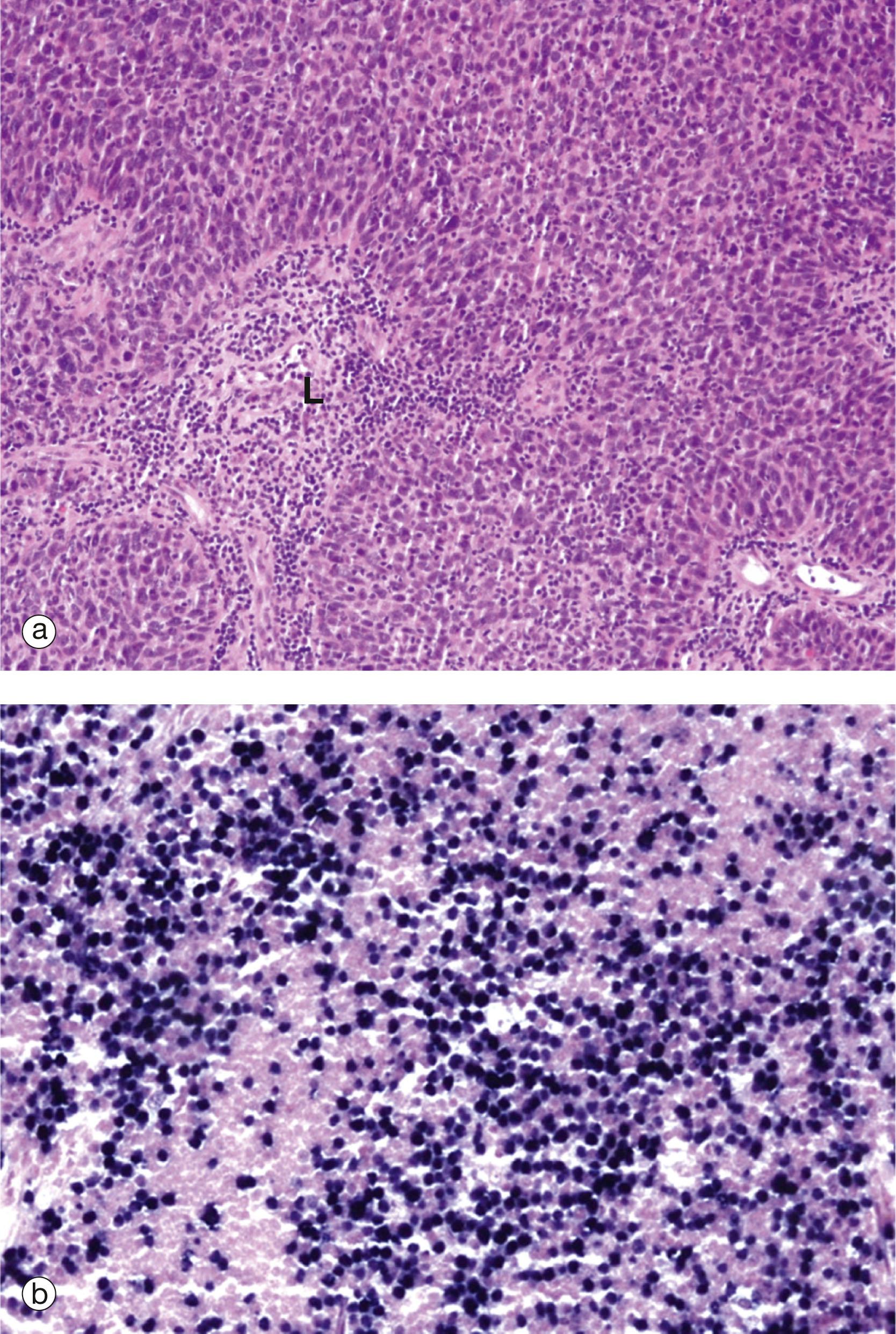
The stratified squamous epithelium of the larynx may undergo hyperplastic or dysplastic change to form benign squamous papillomas or invasive squamous cell carcinoma . Cigarette smoking and alcohol consumption predispose to the development of carcinoma of the larynx.
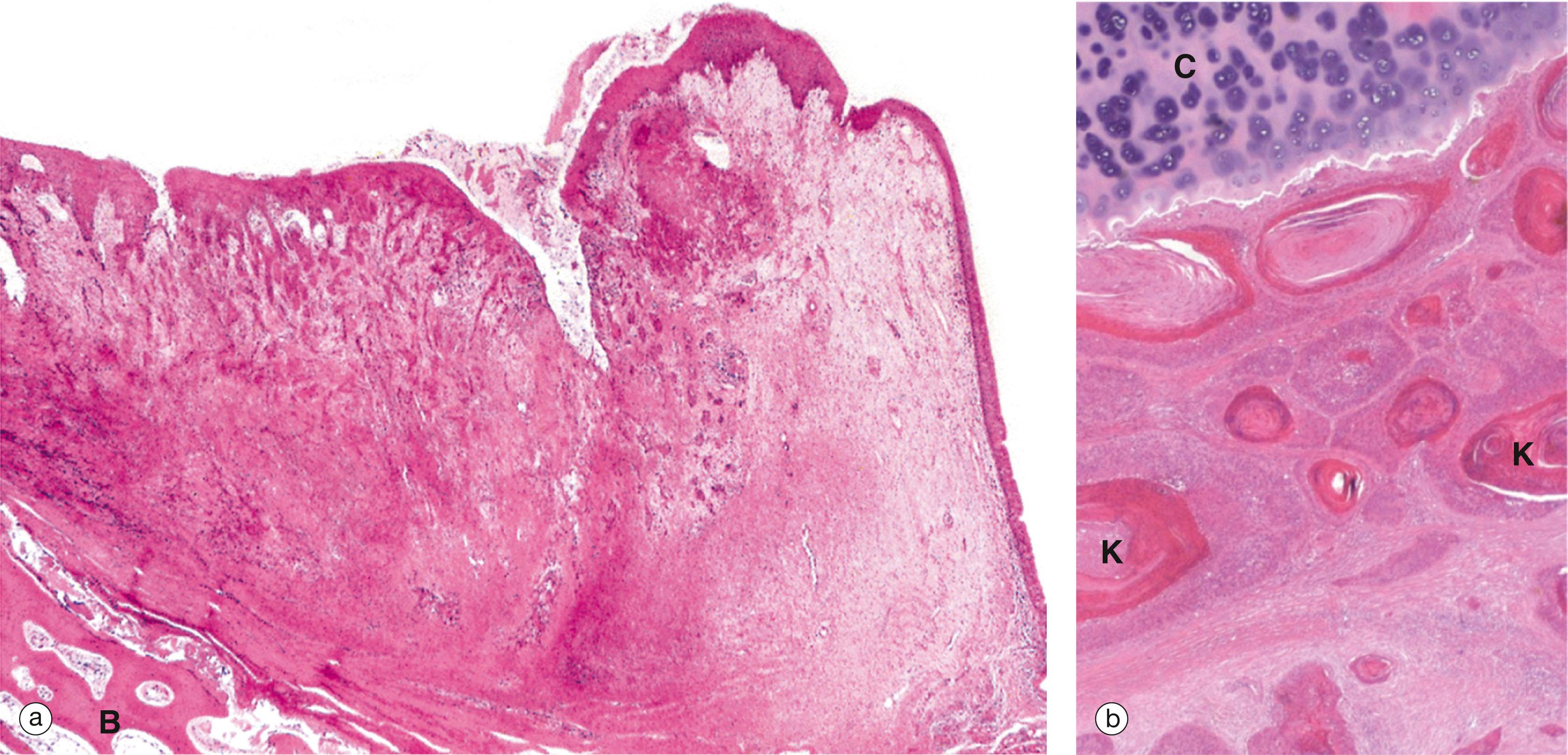
ACF anterior cranial fossa C hyaline cartilage F false cord G seromucinous glands L lymphoid tissue Li vocalis ligament M mucous gland NC nasal cavity NS nasal septum O orbital cavity PS paranasal sinus RE respiratory epithelium S serous gland SE stratified squamous epithelium T trachealis muscle TB turbinate bone TC true cord V blood vessel VM vocalis muscle Vt ventricle
C cartilage CC ciliated cell El elastic fibre F fibroelastic tissue G seromucinous glands GC goblet cell L lymphoid tissue LP lamina propria M smooth muscle Ma mast cell RE respiratory epithelium SM submucosa
A alveolus AD alveolar duct AM alveolar macrophage AR alveolar ring AS alveolar sac Art artery C capillary E endothelial cell M smooth muscle N neuroendocrine cell P 1 type I pneumocyte P 2 type II pneumocyte R respiratory bronchiole RBC red blood cell T terminal bronchiole
A alveolus BM 2 basement membrane C capillary E endothelial cell F fibroblast L lamellar body Mv microvilli NE endothelial cell nucleus P 1 type I pneumocyte P 2 type II pneumocyte S supporting tissue TJ tight junction
Normally, the lungs of newborn infants are able to inflate easily at birth because of the presence of surfactant which overcomes the surface tension of the collapsed fetal lungs.
Surfactant production occurs late in gestation and, if the infant is born prematurely, there is often insufficient surfactant to allow normal breathing after delivery. This can result in severe acute breathing difficulties as well as persistent chronic lung disease in surviving infants. The disorder is known as respiratory distress syndrome of the newborn.
If premature delivery is anticipated during pregnancy, administering corticosteroids to the mother induces surfactant production in the fetal lung and reduces the risk of neonatal lung disease.
The alveolar walls provide an enormous surface area for exchange of gases between the air in the alveoli and the blood in capillaries of the septal wall. Any diseases that reduce the amount of air in the alveoli, or reduce the surface area of the alveoli, or render the alveolar walls thick and impermeable to gases will lead to inadequate oxygenation of blood ( hypoxia ), carbon dioxide retention and breathlessness. All three patterns of disease occur.
In lobar pneumonia, bacteria (usually streptococci) gain access to the alveoli and proliferate rapidly, spreading to all the alveoli in the lobe very rapidly through the alveolar pores. The body responds by mounting an acute inflammatory reaction which fills the alveolar cavities with a mixed fluid/cellular exudate, thus preventing the entry of air into the alveoli of an entire lung lobe, greatly reducing the capacity for adequate oxygenation (see Fig. 12.19 ).
In emphysema, there is progressive destruction of the alveolar ducts, sacs and alveoli, leading to permanent dilatation of the air spaces but a marked reduction in the surface area for gas exchange (see Fig. 12.19 ). There is also loss of the elastic tissue support for the bronchioles, leading to their collapse and air trapping.
In pulmonary fibrosis, the fibroblasts in the alveolar septa, which are normally scanty, increase in number and increase their collagen and elastin production. This thickens the alveolar septum, interposing layers of collagen between the cytoplasm of the type I pneumocyte and alveolar capillaries, thus impeding gaseous exchange. This is a diffuse change throughout the lung parenchyma and leads to slowly progressive hypoxia and breathlessness.
Silicosis of the lungs varies depending on the particulate which is inhaled. In coal miners the silica is a component of the fine coal dust that is inhaled during mining and in haematite miners is a component of iron ore dust. Silica is inhaled into the alveoli and phagocytosed by macrophages. Particles which are not expectorated (coughed up) may remain in the alveolar septa for years where the silica is converted into silicic acid. This stimulates the proliferation of fibroblasts and subsequent collagen deposition. Eventually, lung fibrosis becomes extensive. Asbestos is a silicate which exists in the form of long crystalline needles. When inhaled, these also stimulate lung fibrosis, known as asbestosis . In contrast to silicosis, which requires prolonged inhalation, asbestos need only be inhaled in small quantities on a few occasions to stimulate the development (usually decades later) of a malignant tumour of the pleura ( mesothelioma ).
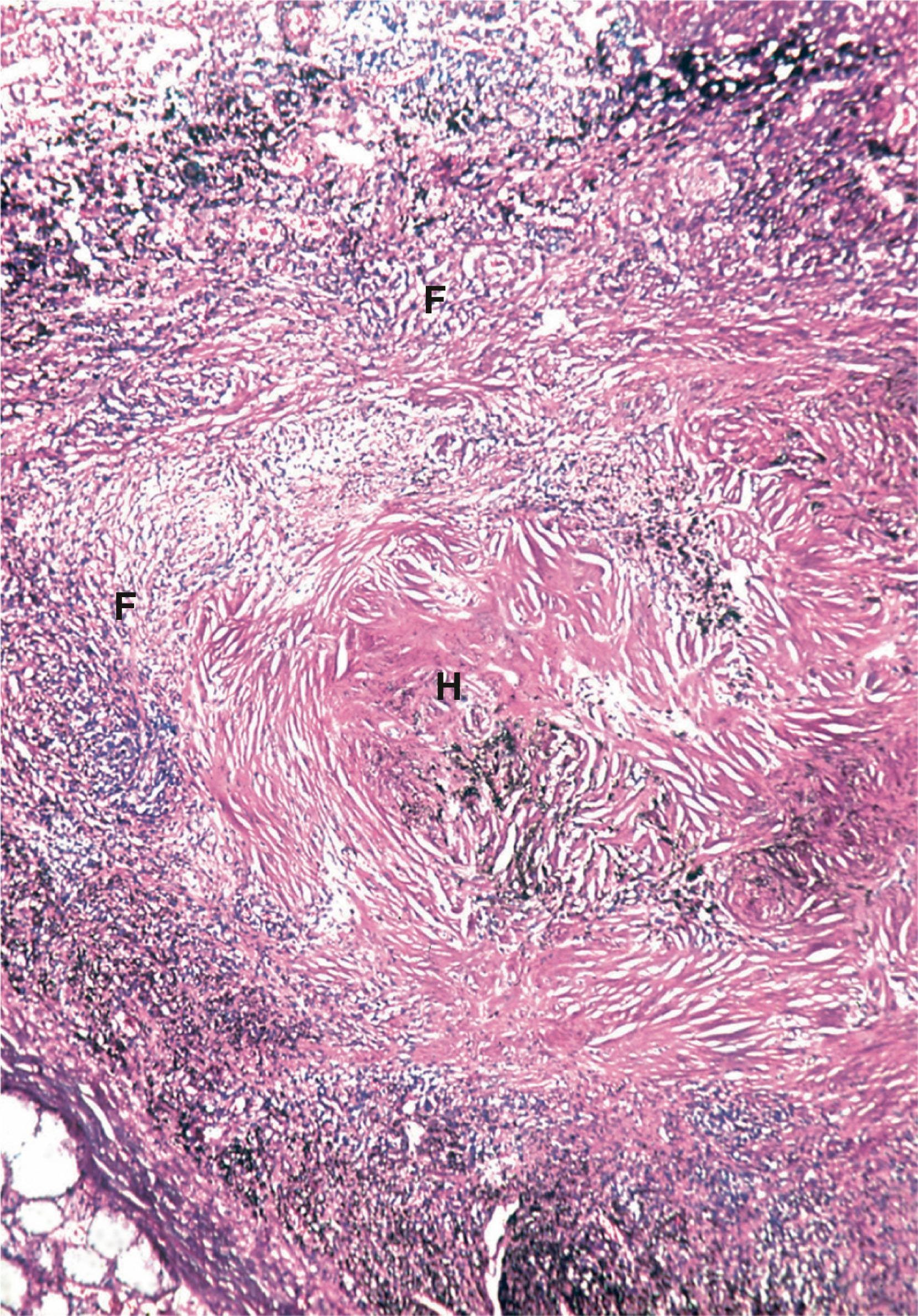
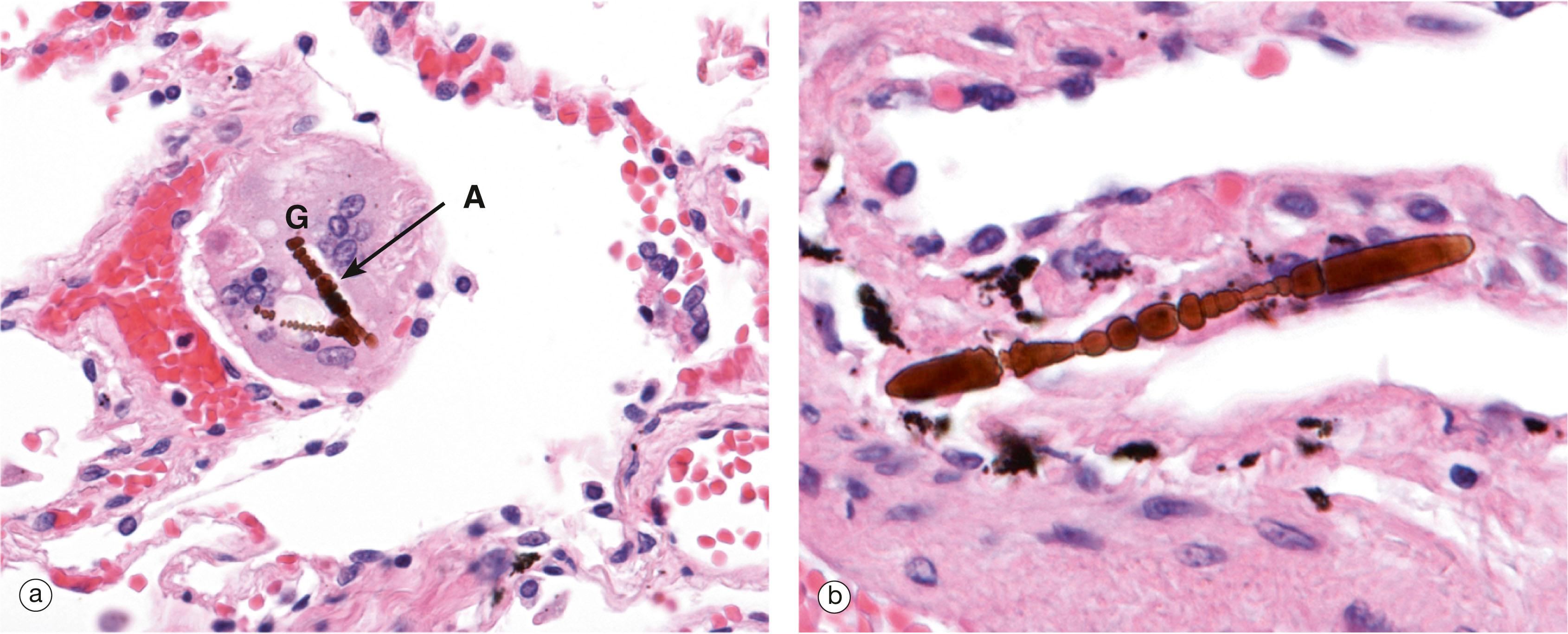
AP alveolar pore B bullae BM basement membrane C capillary E endothelial cell El elastin
Er erythrocyte Ex neutrophil-rich exudate F fibroblast L lipid droplet Ly lysosome M marginal fold Ma macrophage P 1 type I pneumocyte P 2 type II pneumocyte TJ tight junction W air space widening
The majority of malignant tumours of the lungs are carcinomas that arise in the bronchi. Lung carcinomas are broadly classified into small cell carcinoma and non-small carcinomas. Non-small carcinomas are further divided into squamous cell carcinomas, adenocarcinomas and large cell carcinomas which have distinctive histological appearances and treatment options. A few of these tumour types are illustrated below.
Risk factors for the development of lung cancer include cigarette smoking, exposure to radiation and asbestos. Air pollution, lung scarring and genetic predispositions may also be important causative agents.
The diagnosis of lung carcinoma is usually first suspected due to weight loss, breathlessness and haemoptysis (coughing up blood), often in cigarette smokers. Initial investigation typically involves obtaining a chest radiograph, followed by more detailed imaging such as computed tomography (CT) scanning.
If a lung mass is identified, formal diagnosis is usually made on the basis of small amounts of material obtained by minimally invasive techniques such as bronchoscopic biopsy or radiologically guided needle biopsy for peripherally situated lung masses. This is necessary because management is highly dependent upon classification. Most lung cancers actually arise within the epithelium of the bronchi and spread from there into the surrounding lung tissue. Thus, they are often accessible by bronchoscopy where cytological samples may be taken either by washings or brushings of a lesion. More peripheral lesions may be accessed by the technique of fine needle aspiration (FNA), by passing a long needle into the tumour through the chest wall. Least invasive of all is the examination of sputum coughed up by the patient. All of these specimens may be examined by cytological techniques (see Fig. 12.20 ).
The lungs have a double blood supply from the pulmonary vascular system, the major supplier, and the bronchial vascular system. Deoxygenated blood is carried by the systemic veins to the right atrium and into the right ventricle. The right ventricle pumps the blood through the pulmonary valve into the main pulmonary arterial trunk and then into the right and left pulmonary arteries . The main right and left pulmonary arteries enter the lungs at the lung hila alongside the main bronchi and follow the course of the bronchi into the lungs, dividing into progressively smaller branches as the bronchi divide. With each division, the arteries become smaller and the structure of their wall changes. The proximal pulmonary arteries, the main pulmonary trunk and large pulmonary arteries, are elastic arteries similar to the aorta (see Fig. 8.9 ) but thinner walled, with elastic fibres an important component of the tunica media. Beyond the point where the bronchi lose their cartilage plates to become bronchioles, the pulmonary arteries become muscular arteries with distinct elastic laminae and a tunica media that is almost completely composed of smooth muscle. The transition from elastic to muscular arteries is gradual. The distal pulmonary arteries continue to follow the distribution of bronchioles and become progressively smaller as the tunica media becomes thinner, eventually becoming discontinuous in the pulmonary arterioles. The small pulmonary arterioles transfer blood into the pulmonary capillaries (see Figs 12.13 and 12.14 ) where it becomes oxygenated and it is then passed through pulmonary venules (indistinguishable from arterioles) into a series of gradually enlarging venules and veins. Some of these run in the fibrocollagenous septa of the lung before becoming medium-sized veins with a distinct tunica media and ill-formed elastic laminae. The largest pulmonary veins, that leave the lungs at the hilar regions and pass to the left atrium, show elastic fibres scattered in the media, rather than in distinct elastic laminae.
The bronchial vascular system is minor and provides lung structures such as bronchi with oxygenated blood at systemic pressure. The bronchial arteries are lateral branches of the thoracic aorta and run with the bronchial tree as far as respiratory bronchiole level where they anastomose with the pulmonary vascular system. The small bronchial veins and venules also anastomose freely with pulmonary veins and venules. The main bronchial veins drain into the azygos and hemiazygos veins .
A adenocarcinoma cells Ad tunica adventitia Ap apoptosis B intercellular bridges E endothelial cell Ep Epithelial cells EEL external elastic lamina EL elastic lamellae FS fibrous septum G Malignant glands I tunica intima IEL internal elastic lamina K keratinisation M tunica media N necrosis SM smooth muscle V vein
The two cavities in the thorax which house the right and left lungs, the pleural cavities , are lined internally by a thin smooth layer, the pleura , which is also reflected over the external surfaces of the lungs. The part of the pleura which forms the internal lining of the chest cavities is called the parietal pleura and that which externally coats the lungs, the visceral pleura . The parietal and visceral pleurae are normally in contact but separated by a potential space containing a small amount of serous fluid that lubricates the movement of visceral upon parietal pleura during breathing.
Smooth movement of parietal and visceral pleura during inspiration and expiration is impaired when the smooth pleural surfaces become damaged and roughened, particularly during bacterial infections. This produces the symptom called pleurisy , a severe stabbing pain in the chest wall at the site of pleural damage during inspiration and expiration, often accompanied by a scratching noise on auscultation ( pleural friction rub ) in time with respiratory movements. Damage to the pleura can be followed by fibrous scar formation, leading to fibrous thickening and often adhesions between the two facing surfaces of the pleura. Some of the pulmonary lymphatics run in fibrous septa and empty their contents into the pleural cavity. If the lungs become severely waterlogged (e.g. due to heart failure), these lymphatics can disgorge large quantities of fluid into the pleural cavity (pleural effusion). Unfortunately, these lymphatics can also carry bacteria and tumour cells into the pleural cavity from the lung, producing infected pleural effusions and malignant pleural effusions, respectively.
Only one form of primary cancer occurs in the pleura, malignant mesothelioma, which is known to be associated with the inhalation of some forms of asbestos fibre and is illustrated below.
F fibrous tissue G glandular elements L lymphatic space Me mesothelium P pleura Pa papillary elements S Fibrous septum
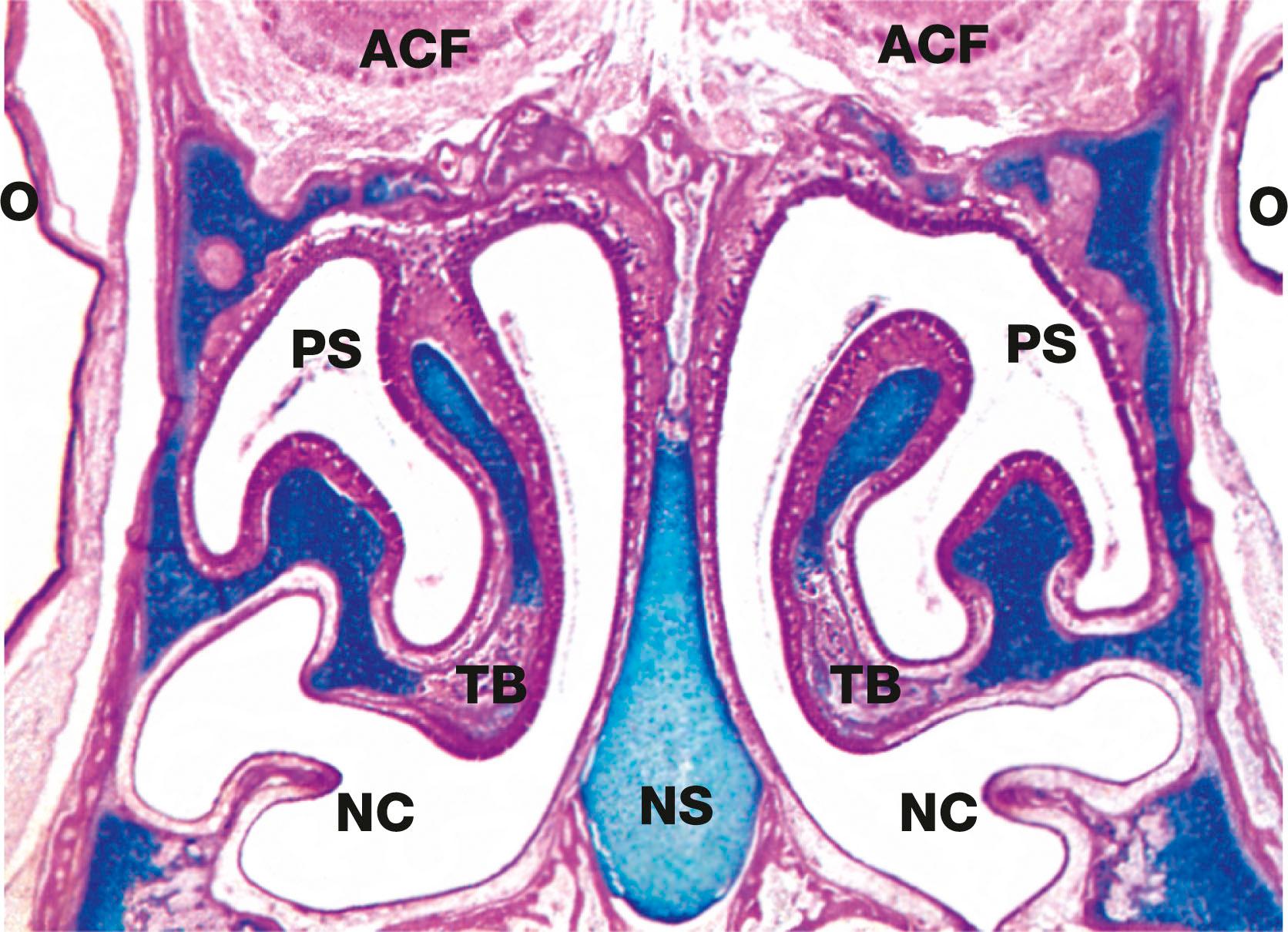
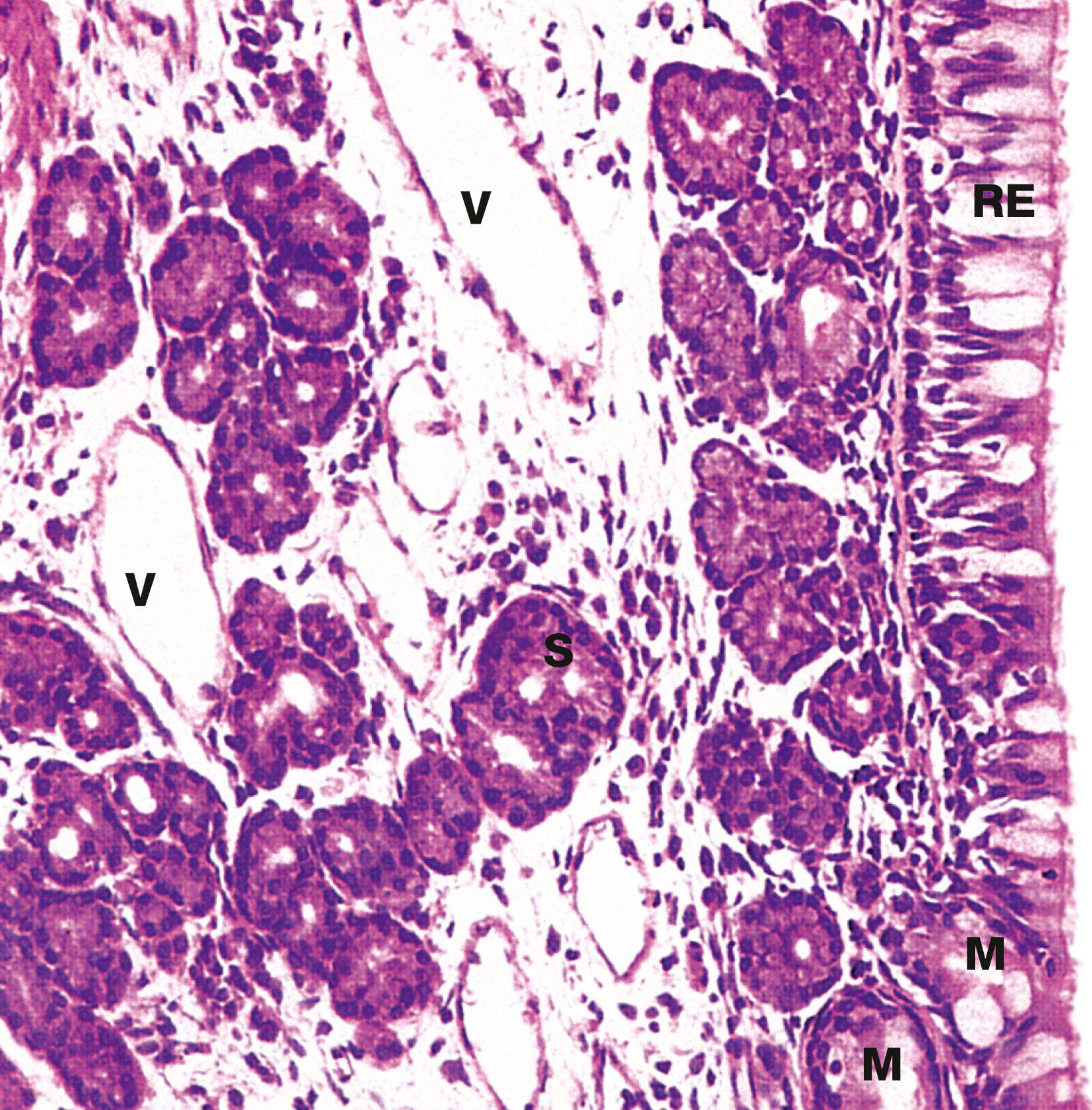
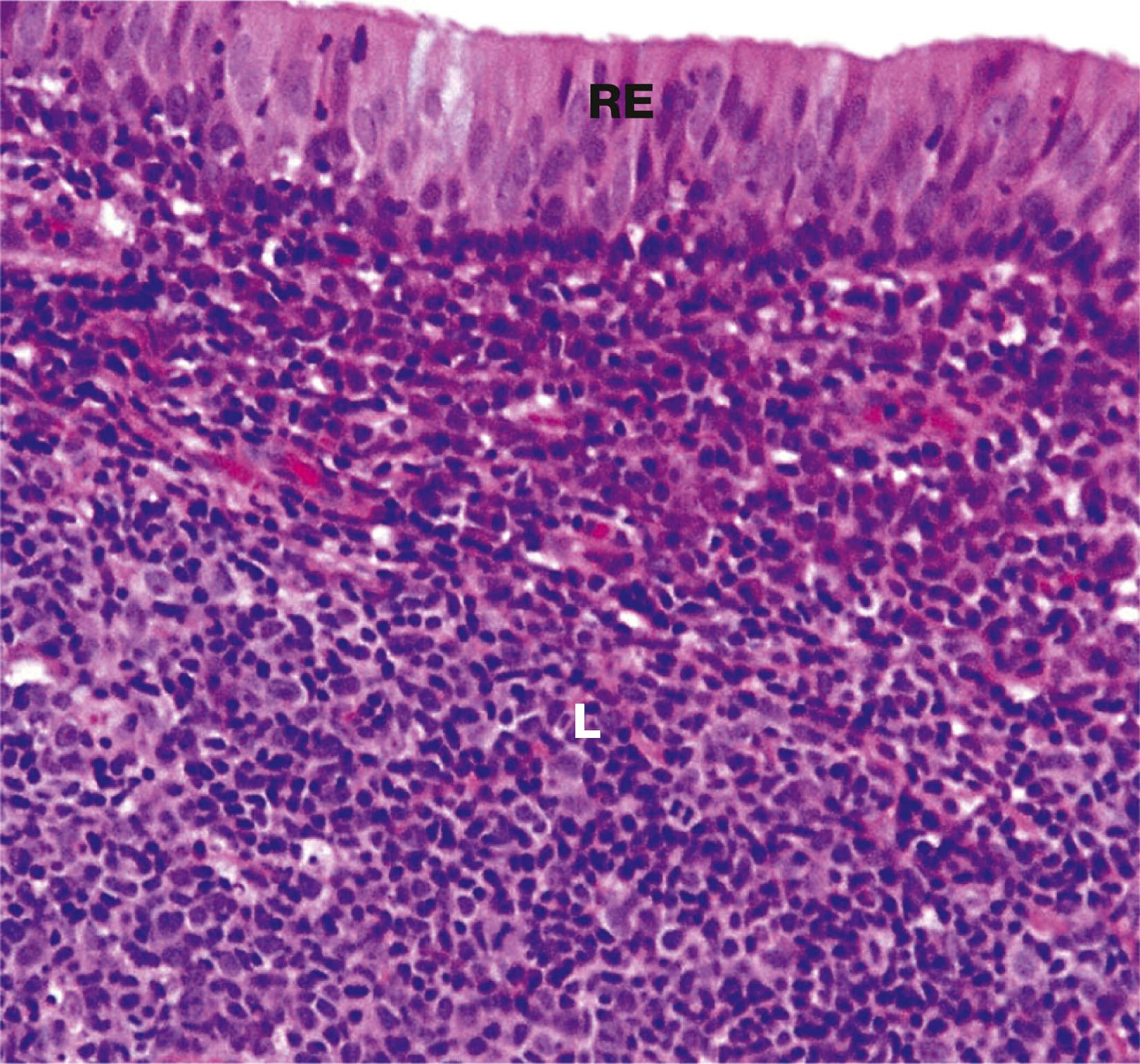
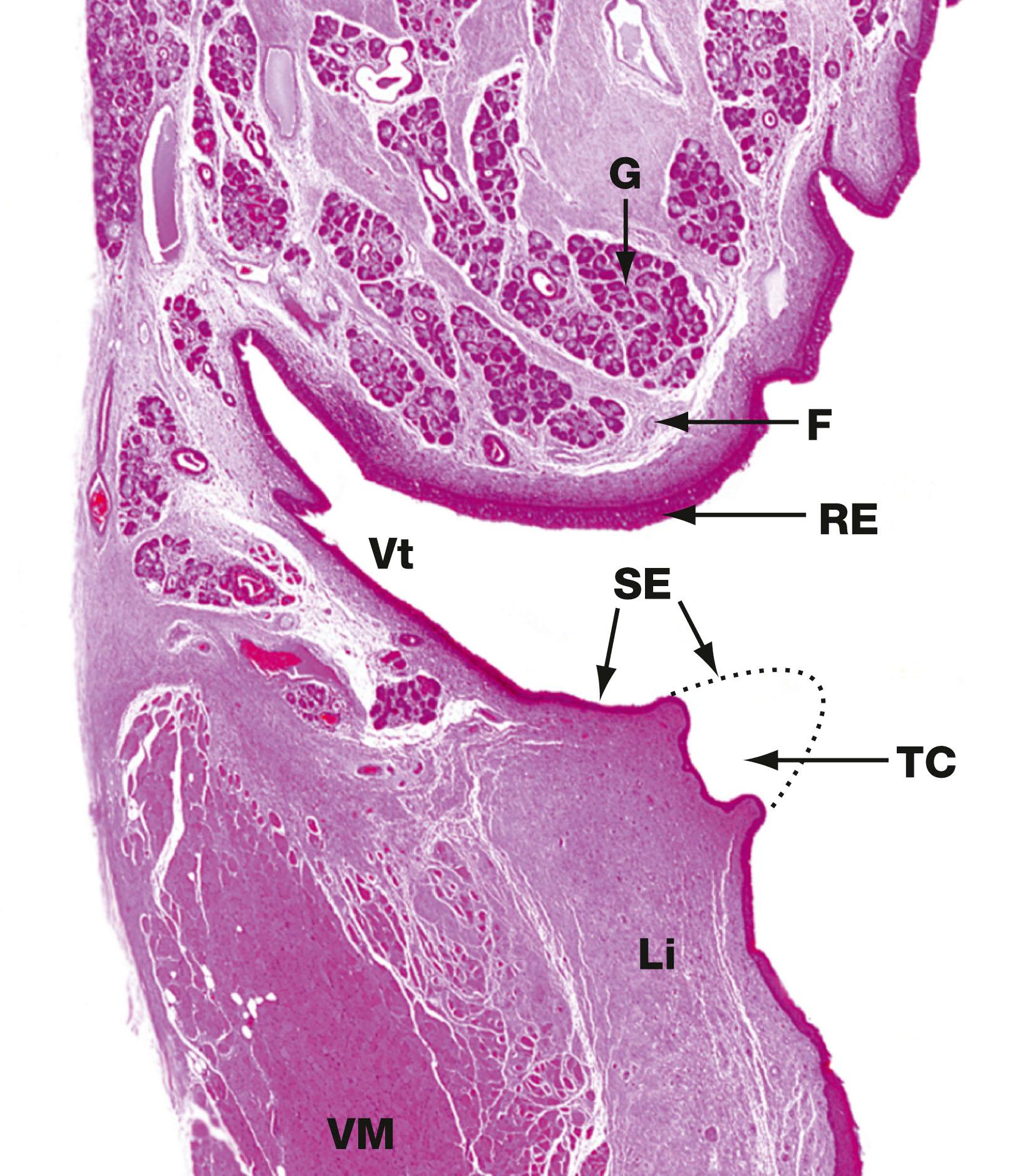
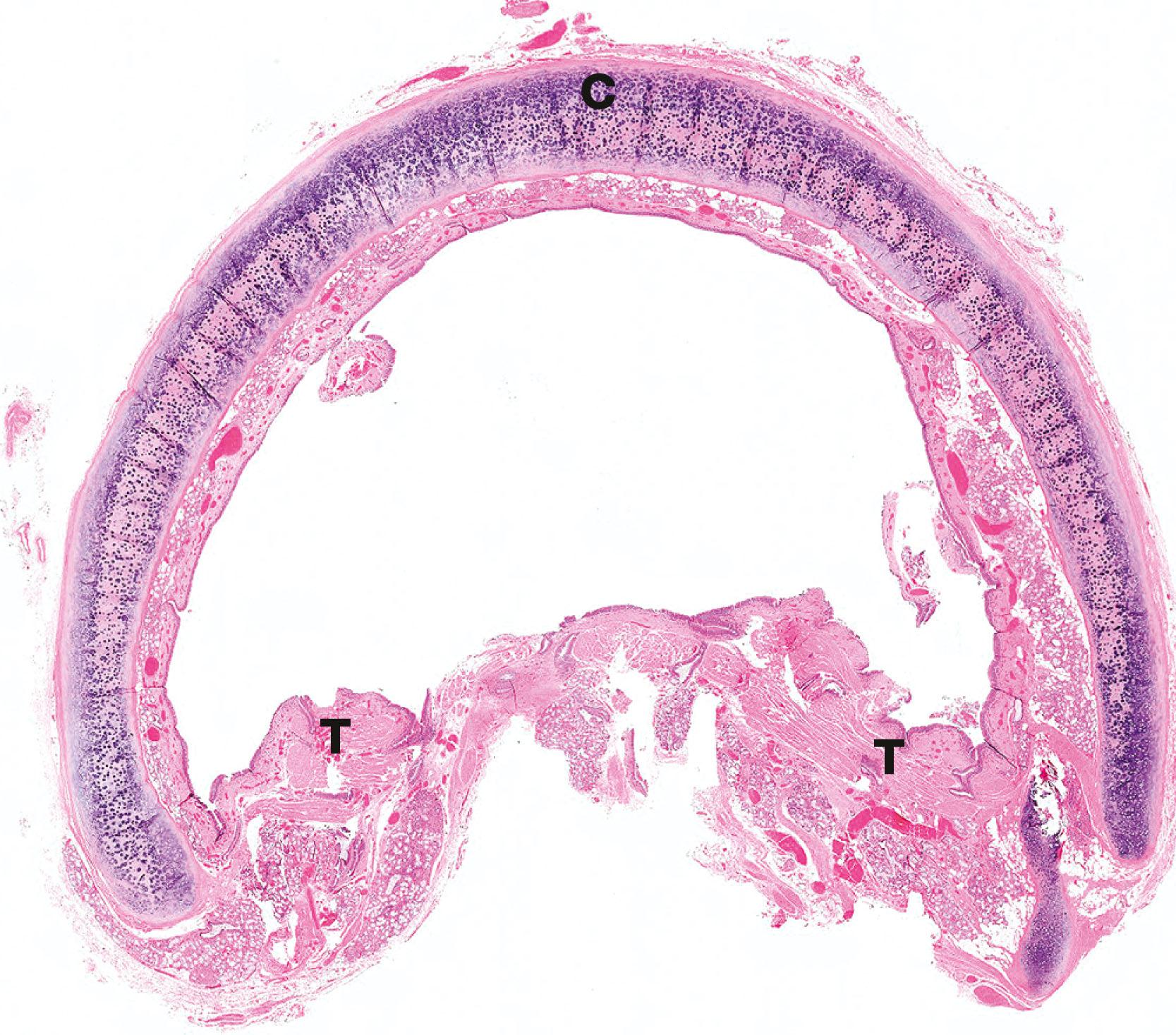

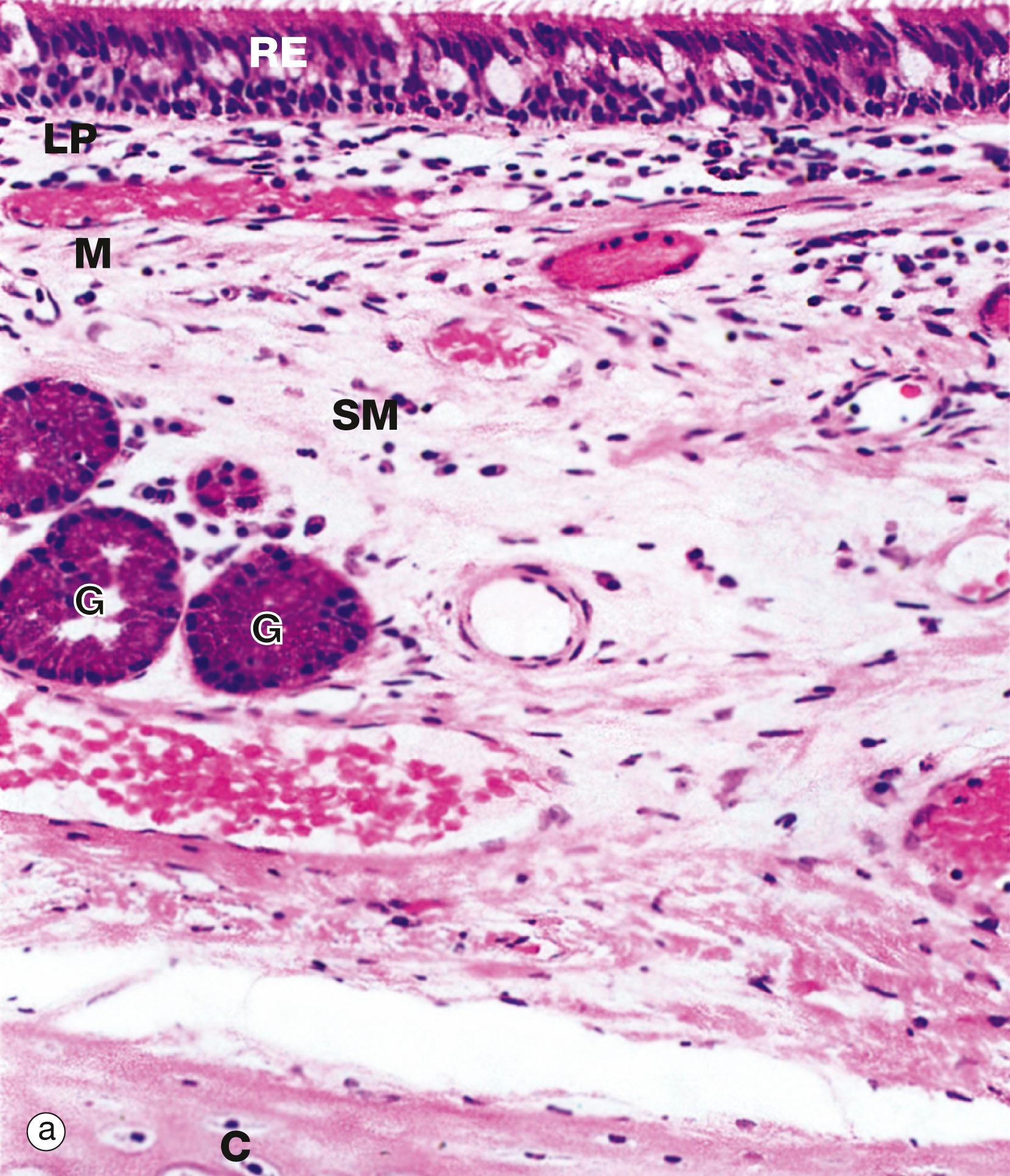
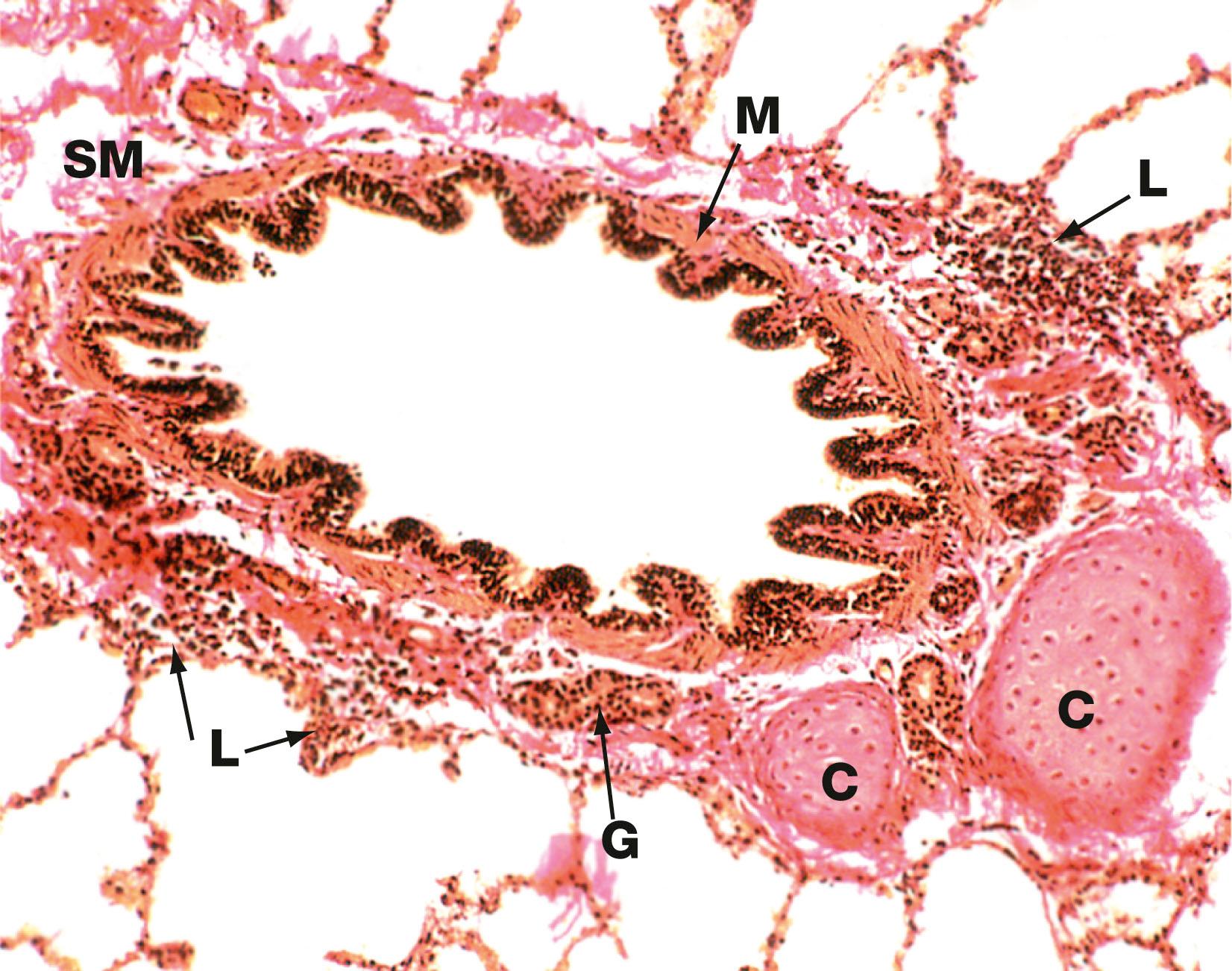
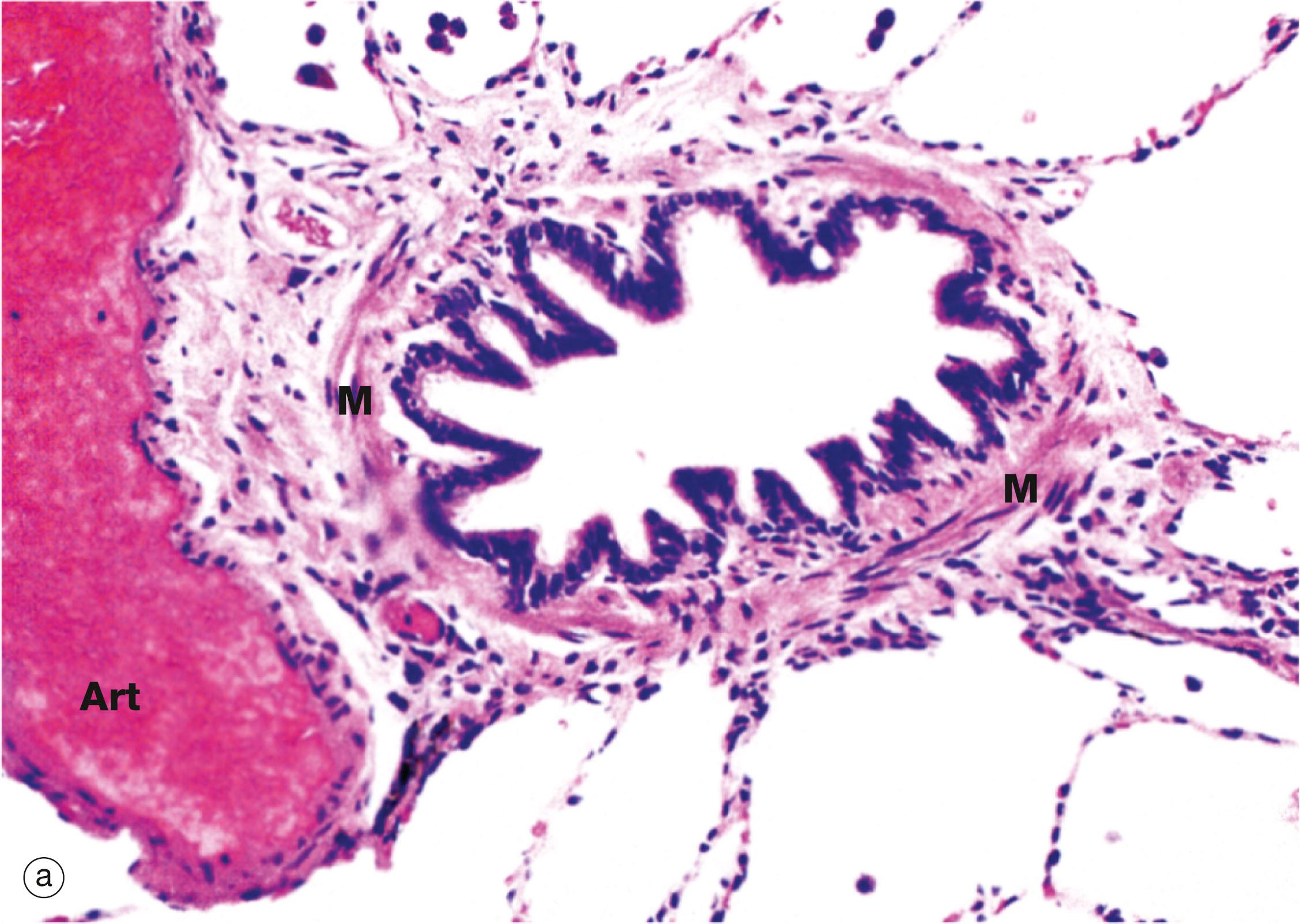
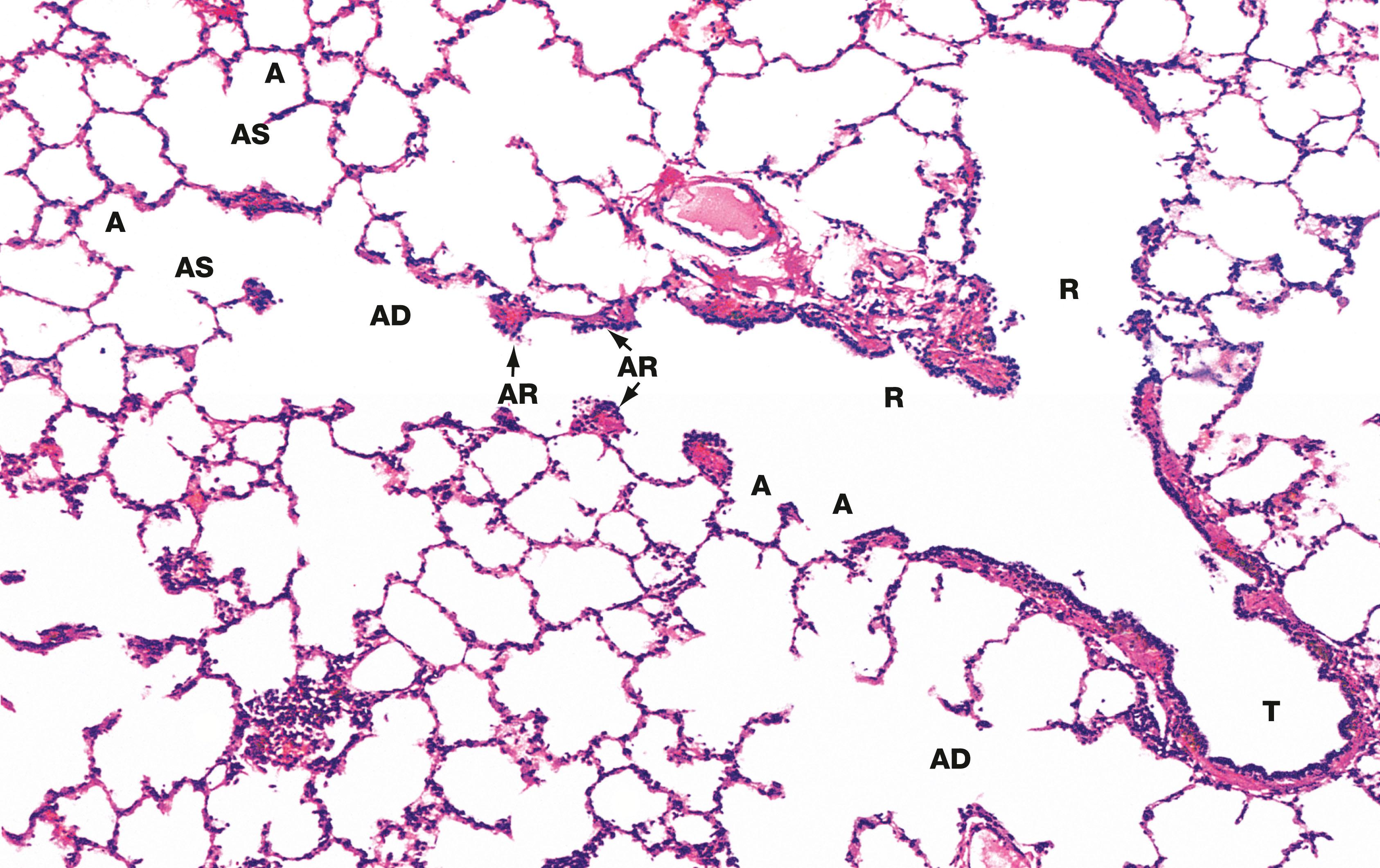
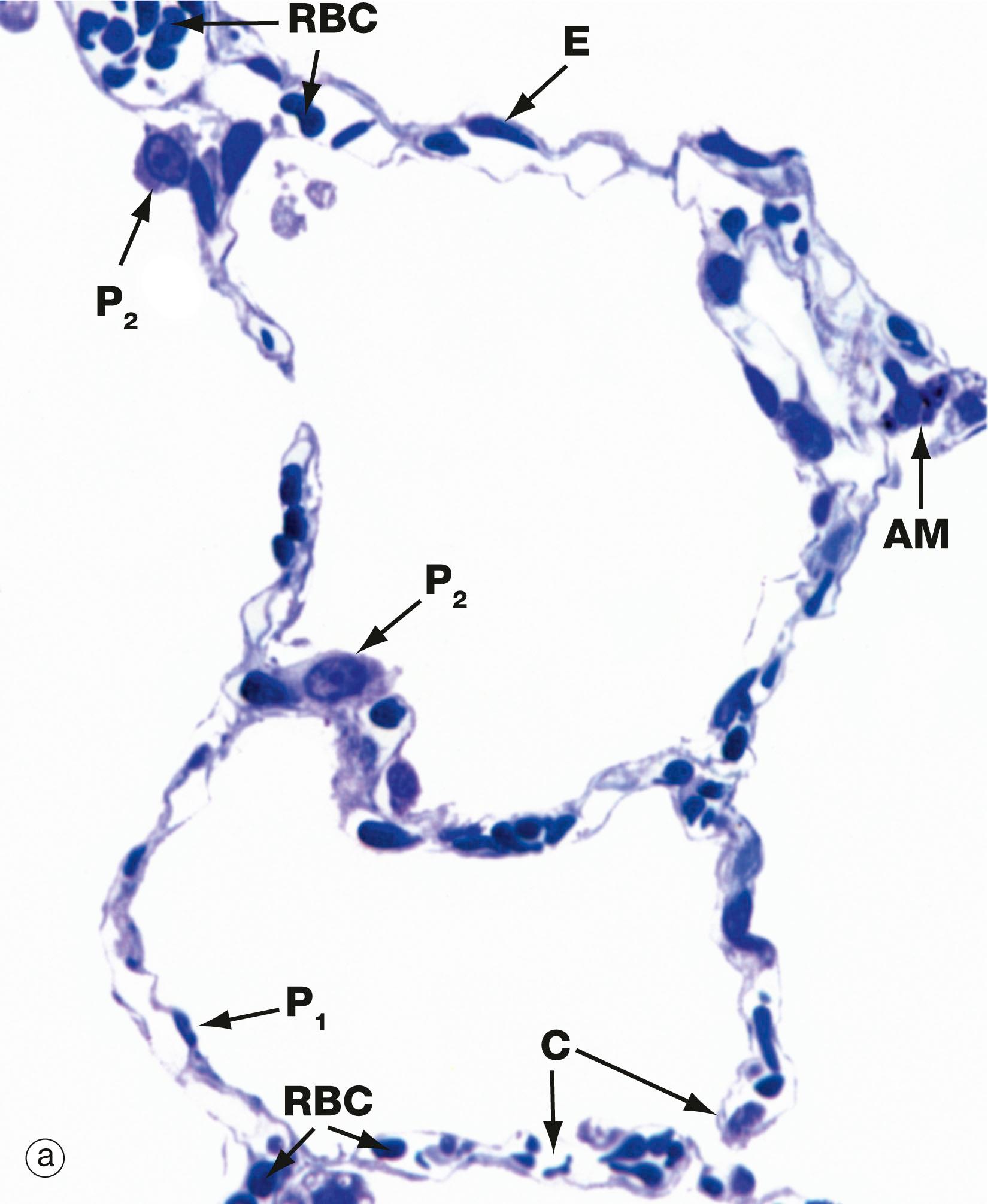
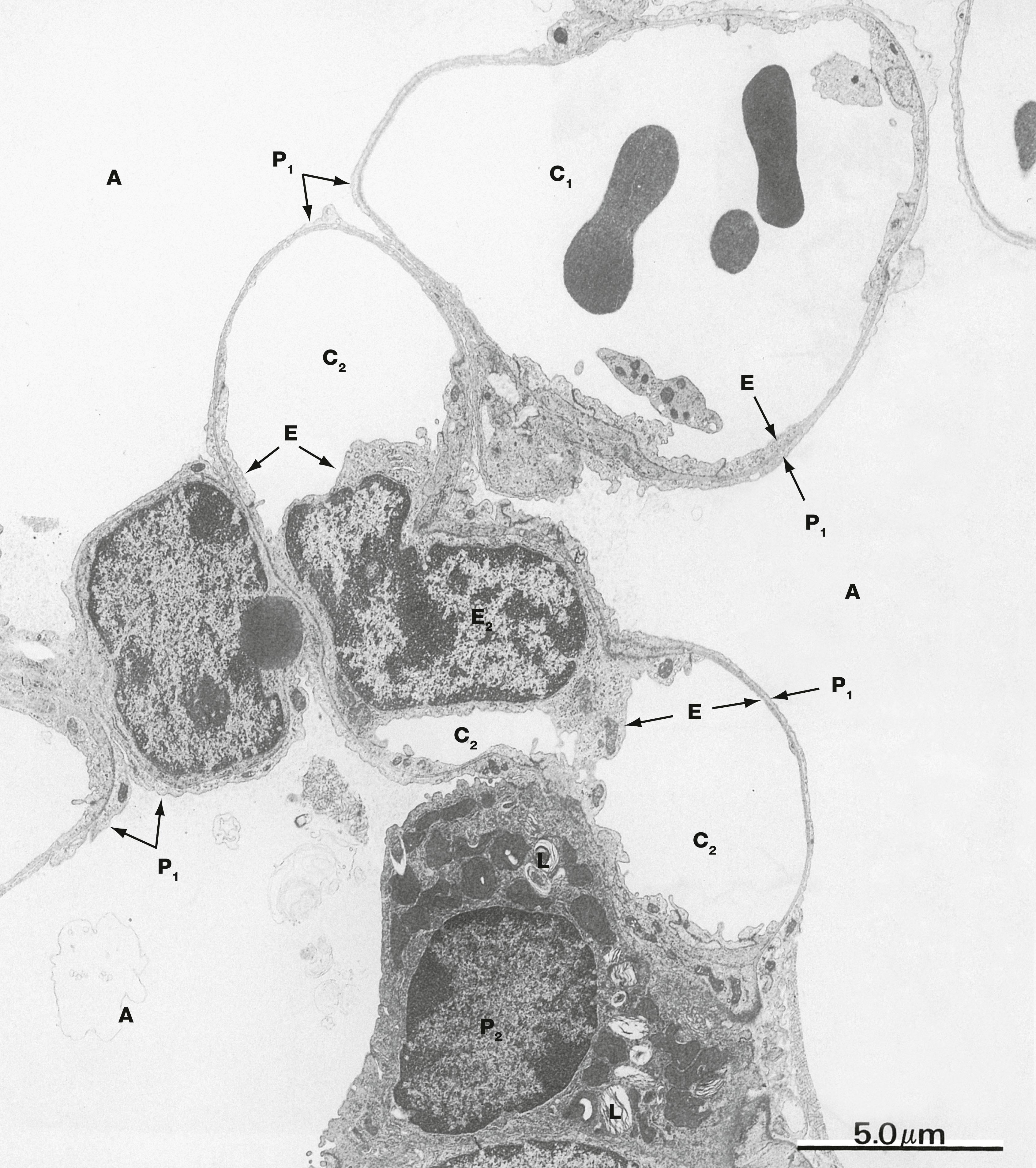
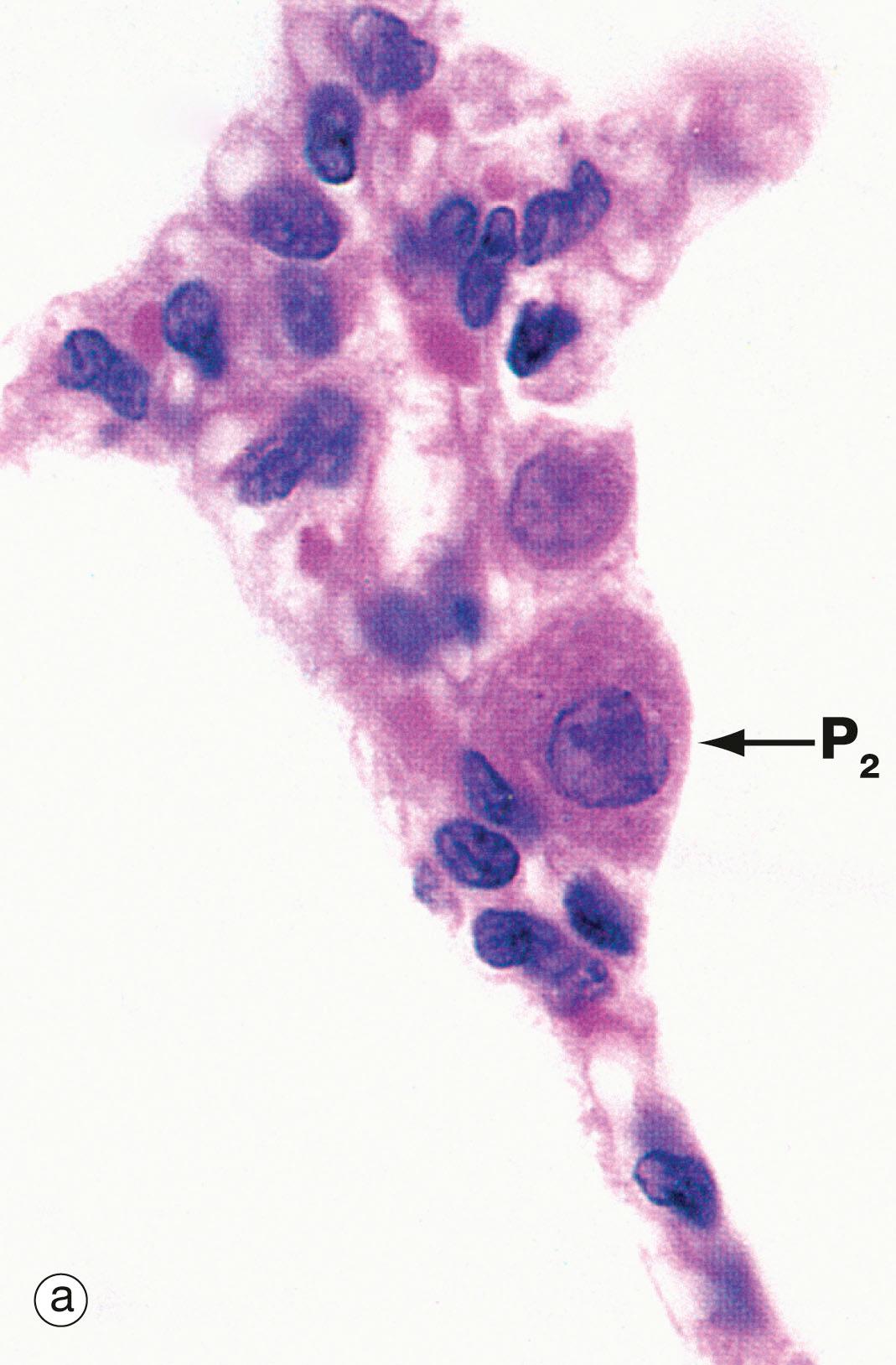
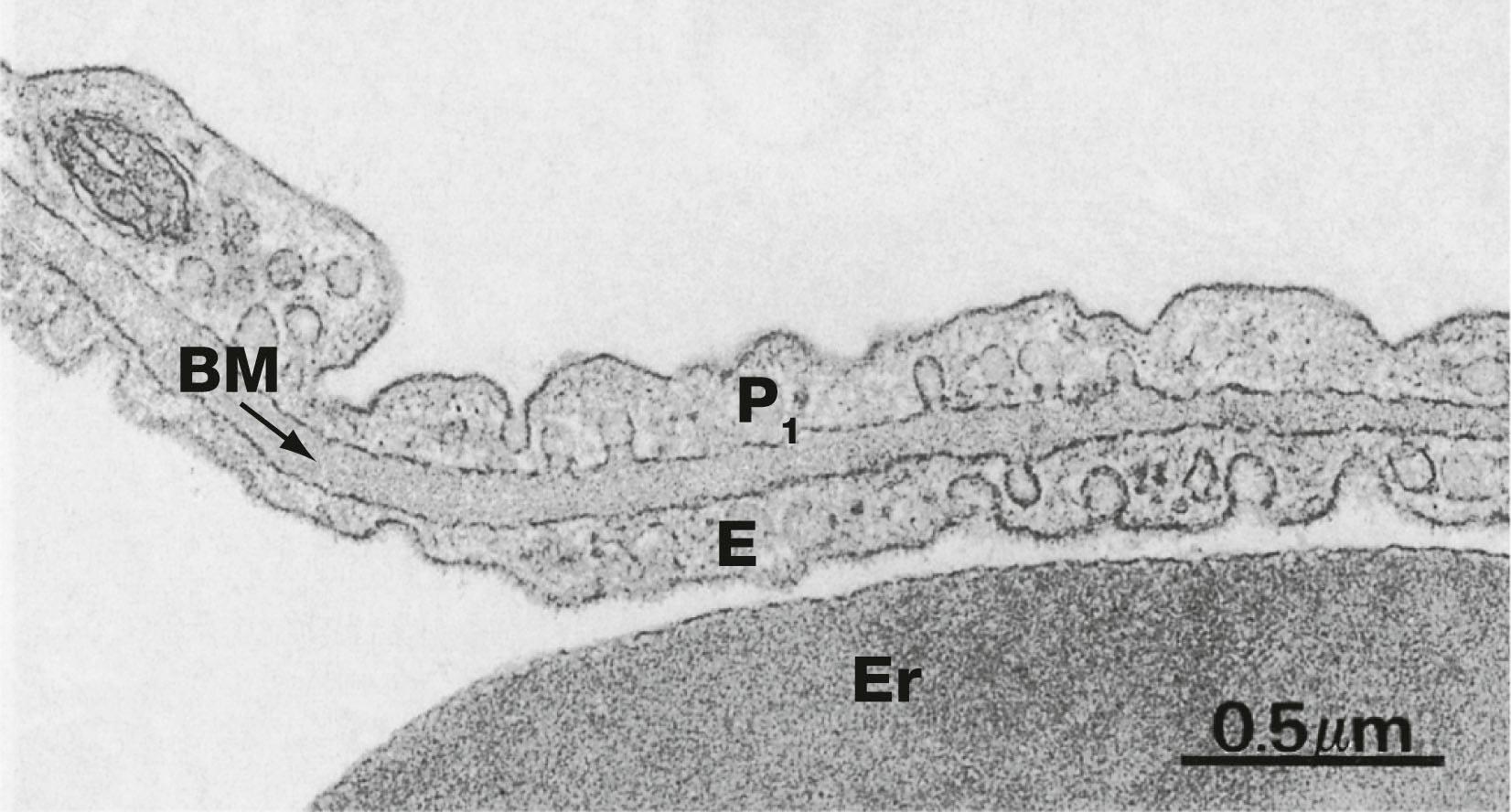

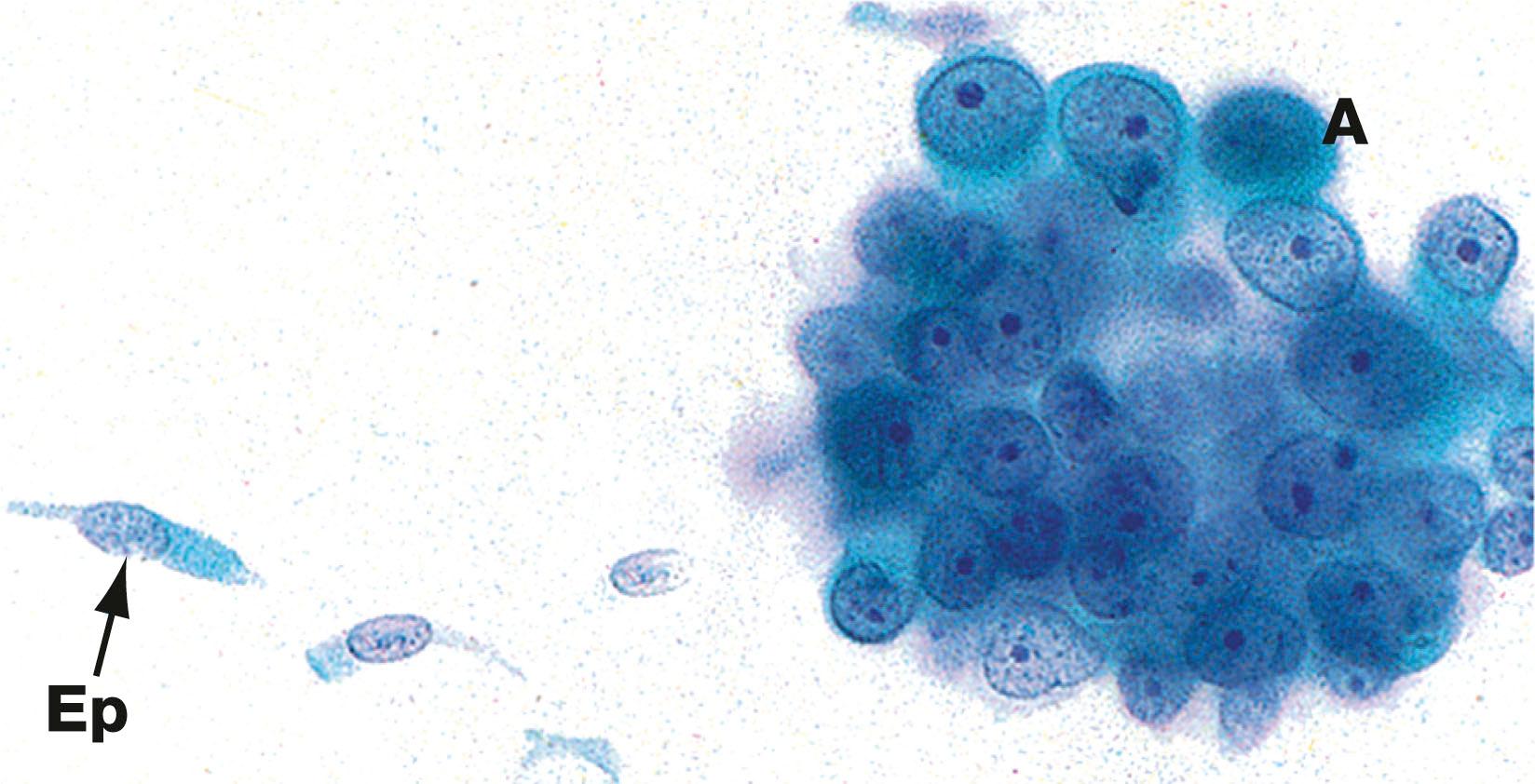
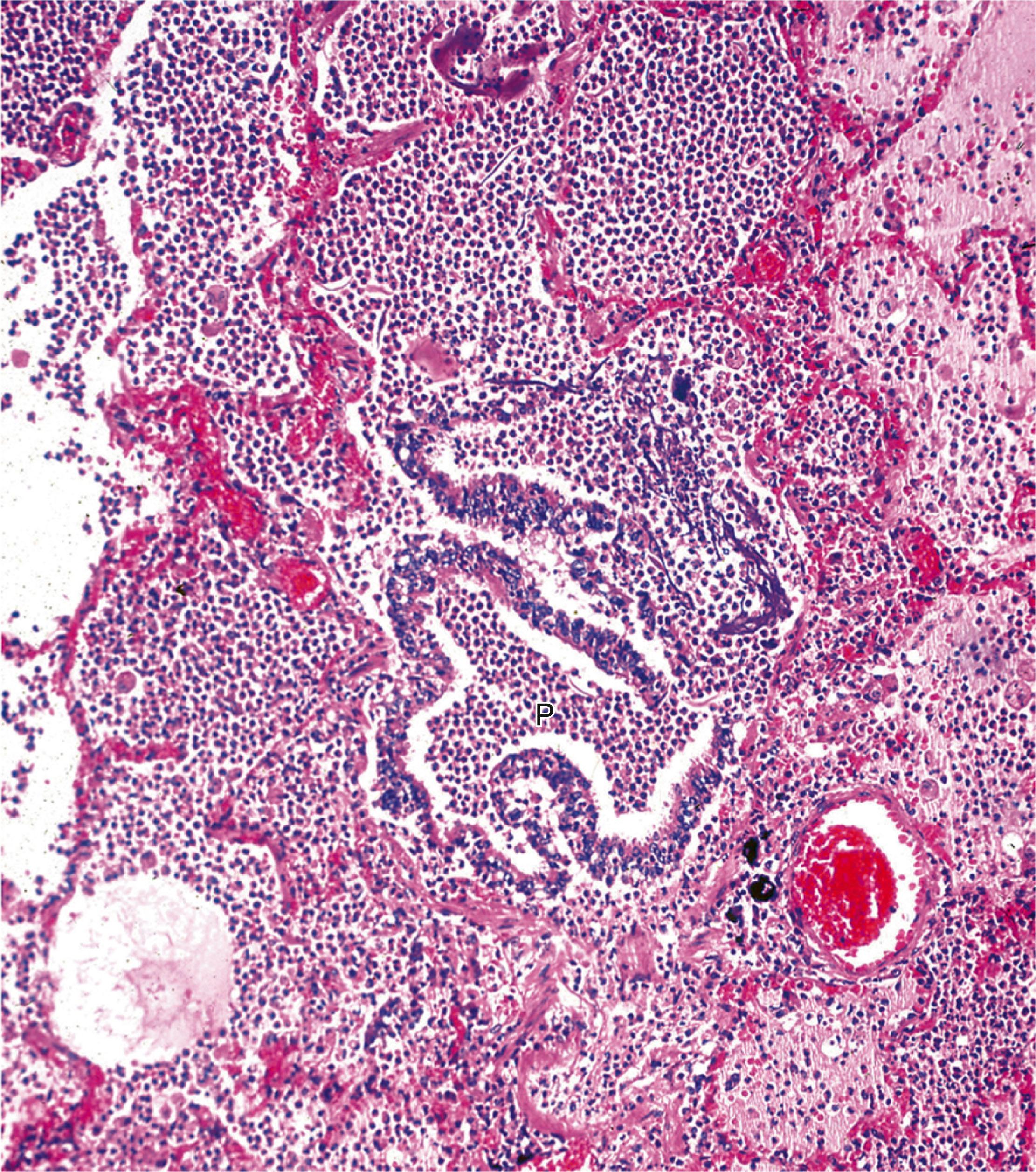
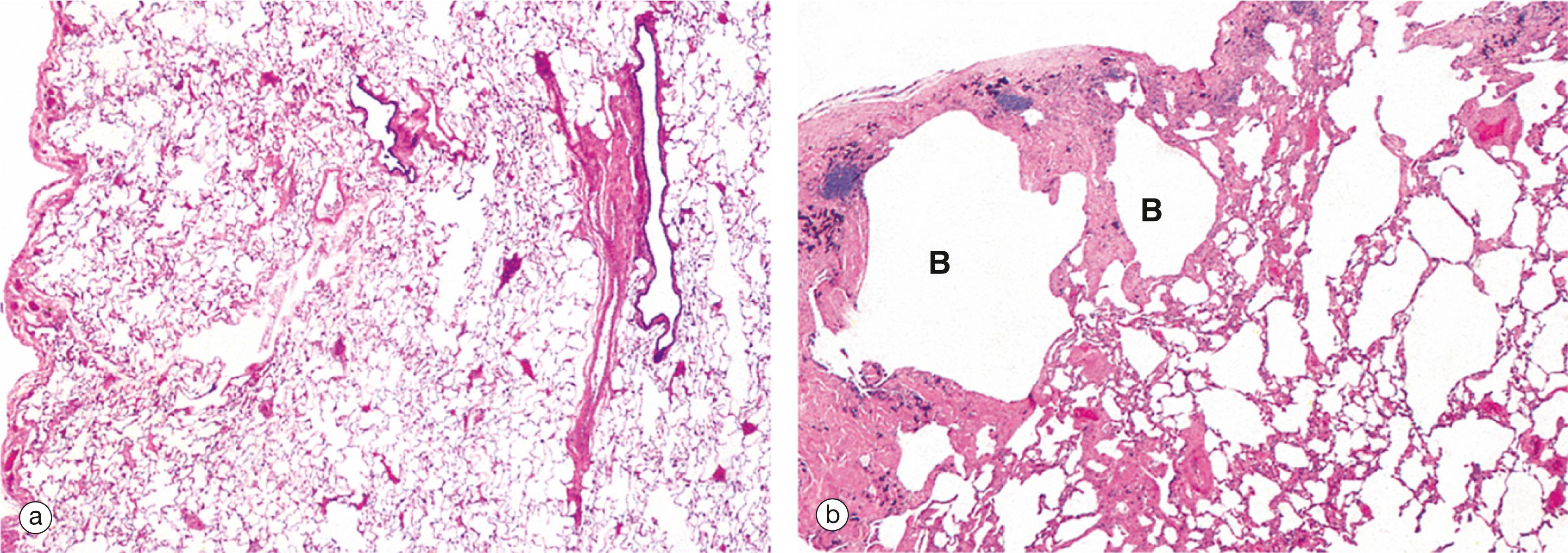

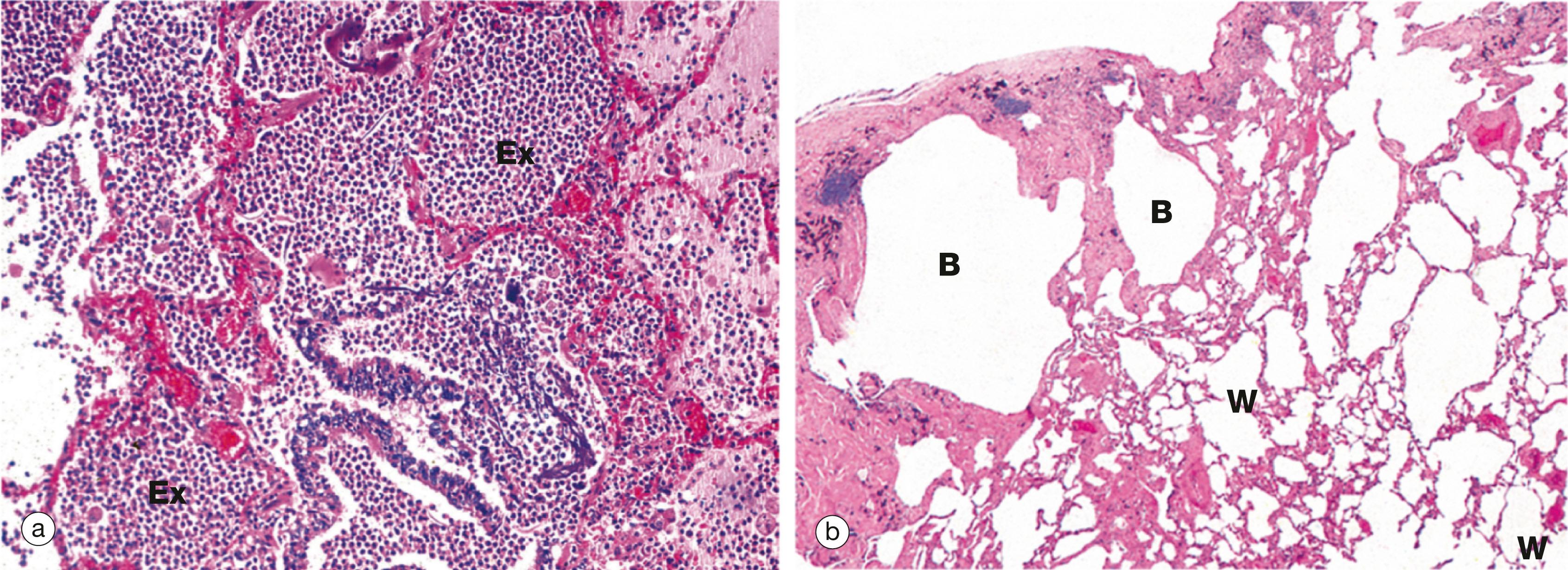
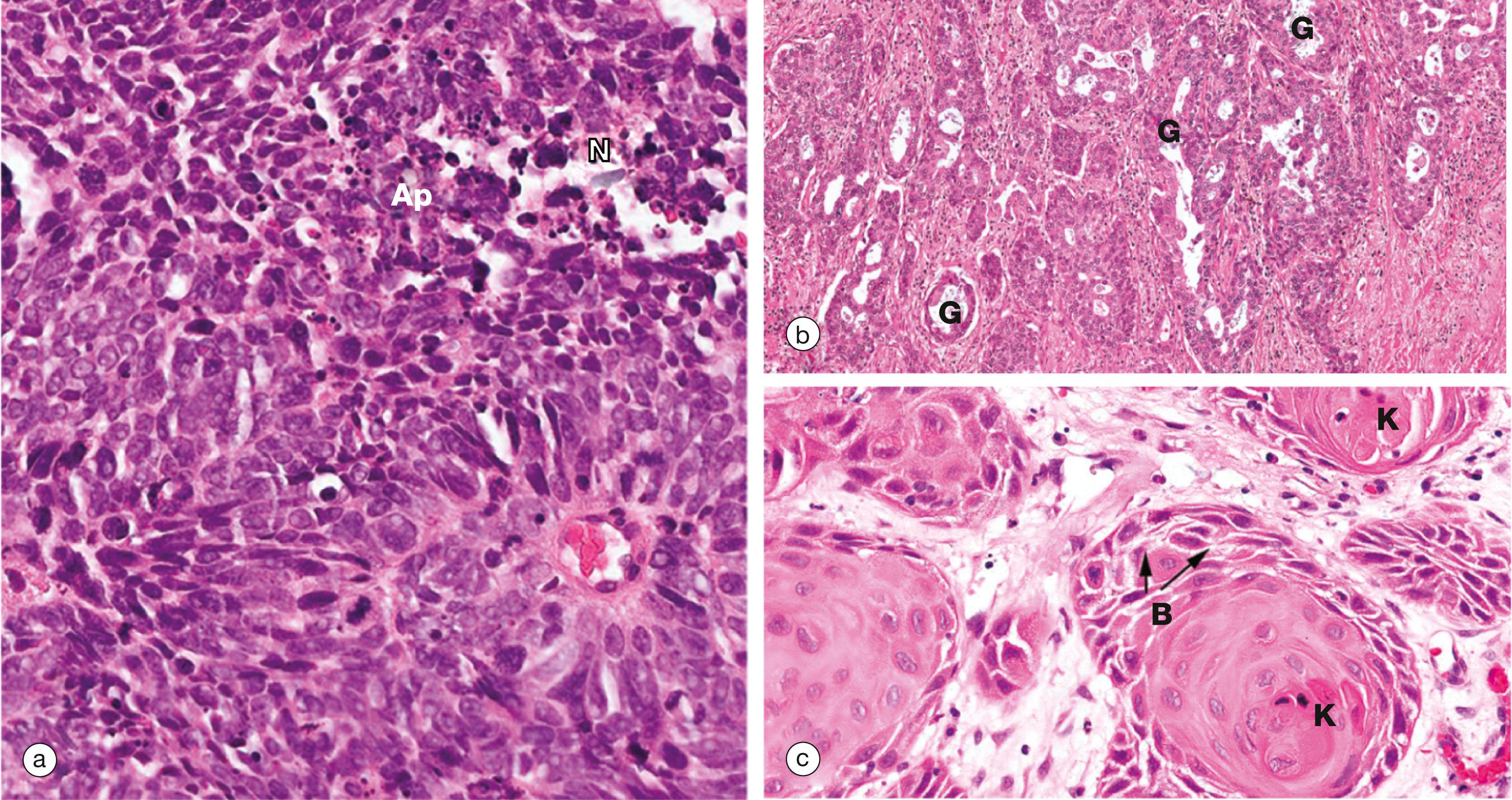
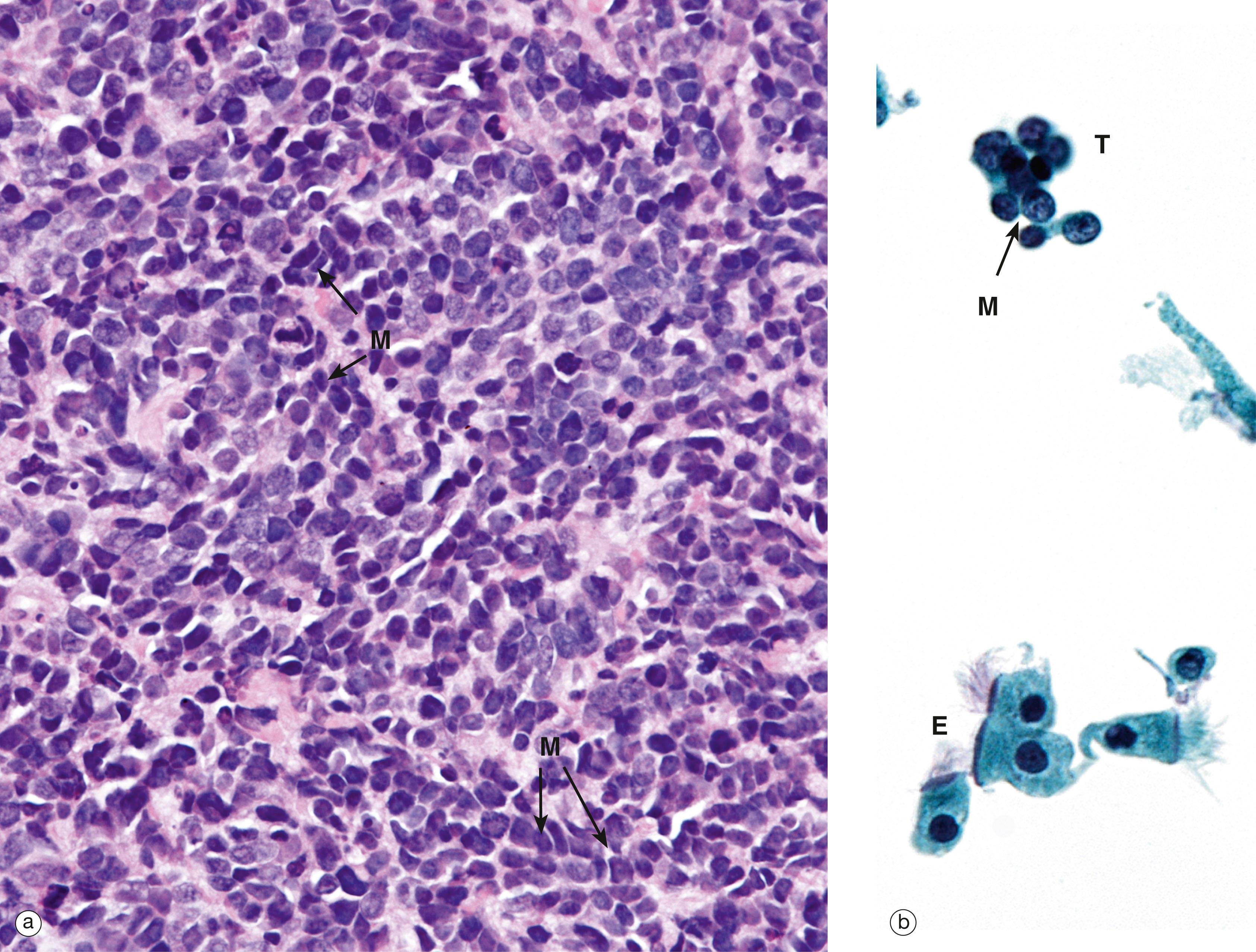
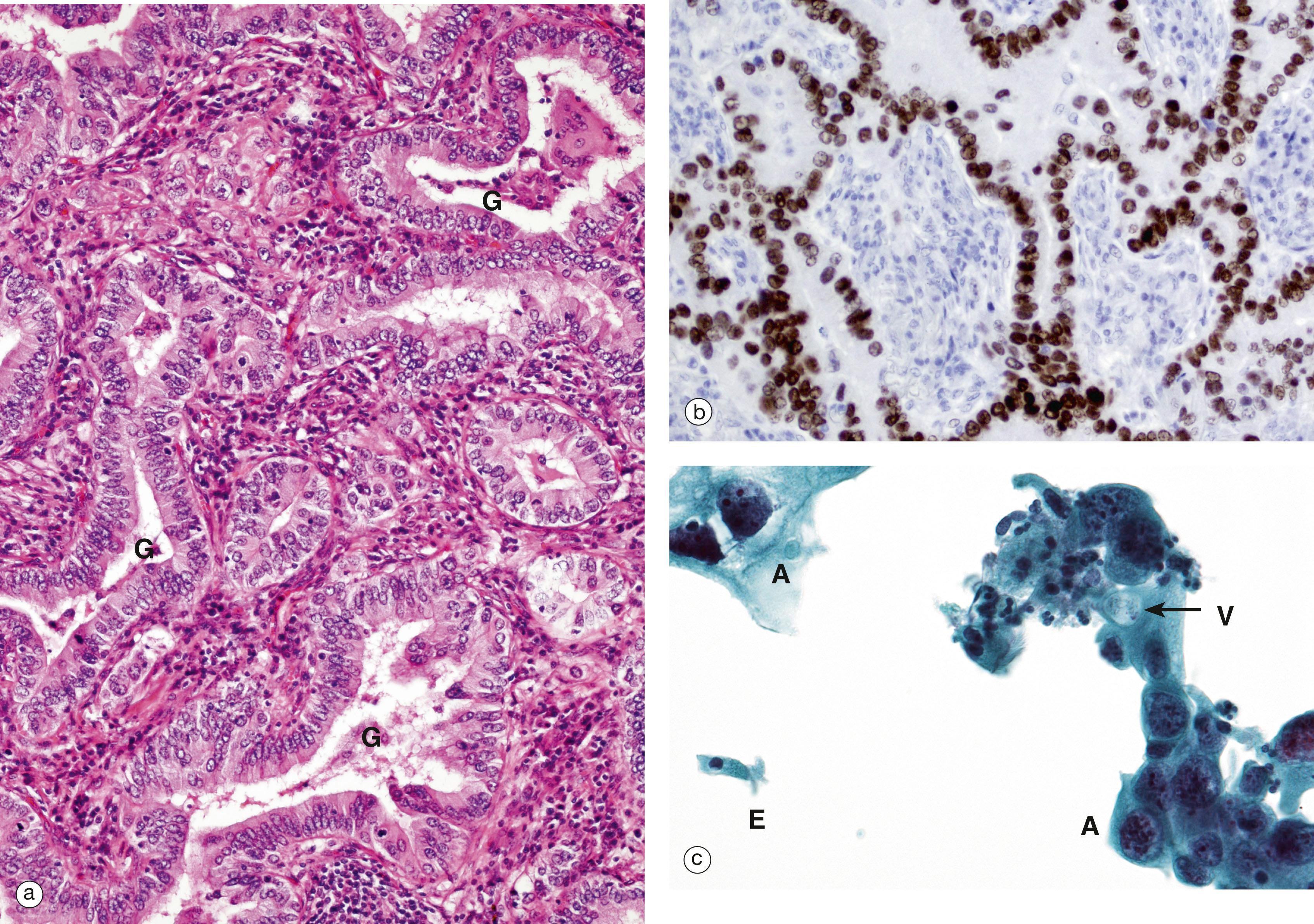
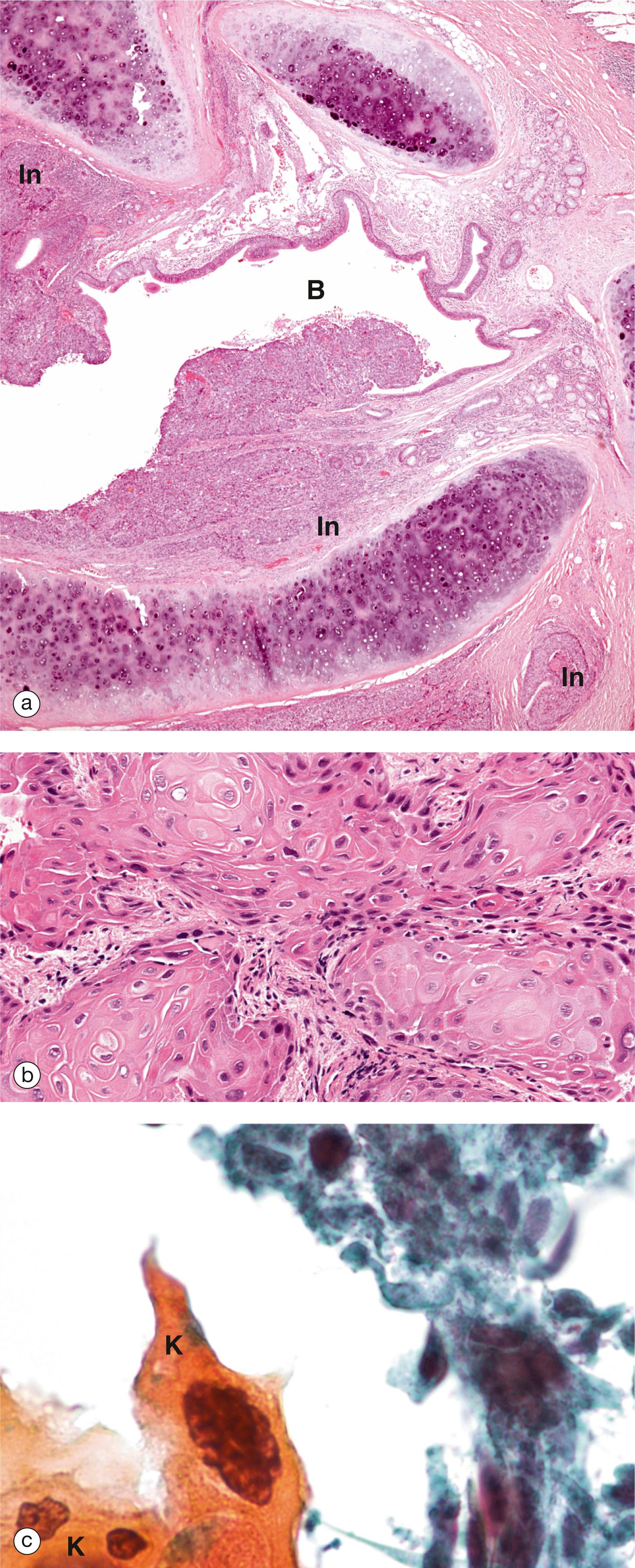
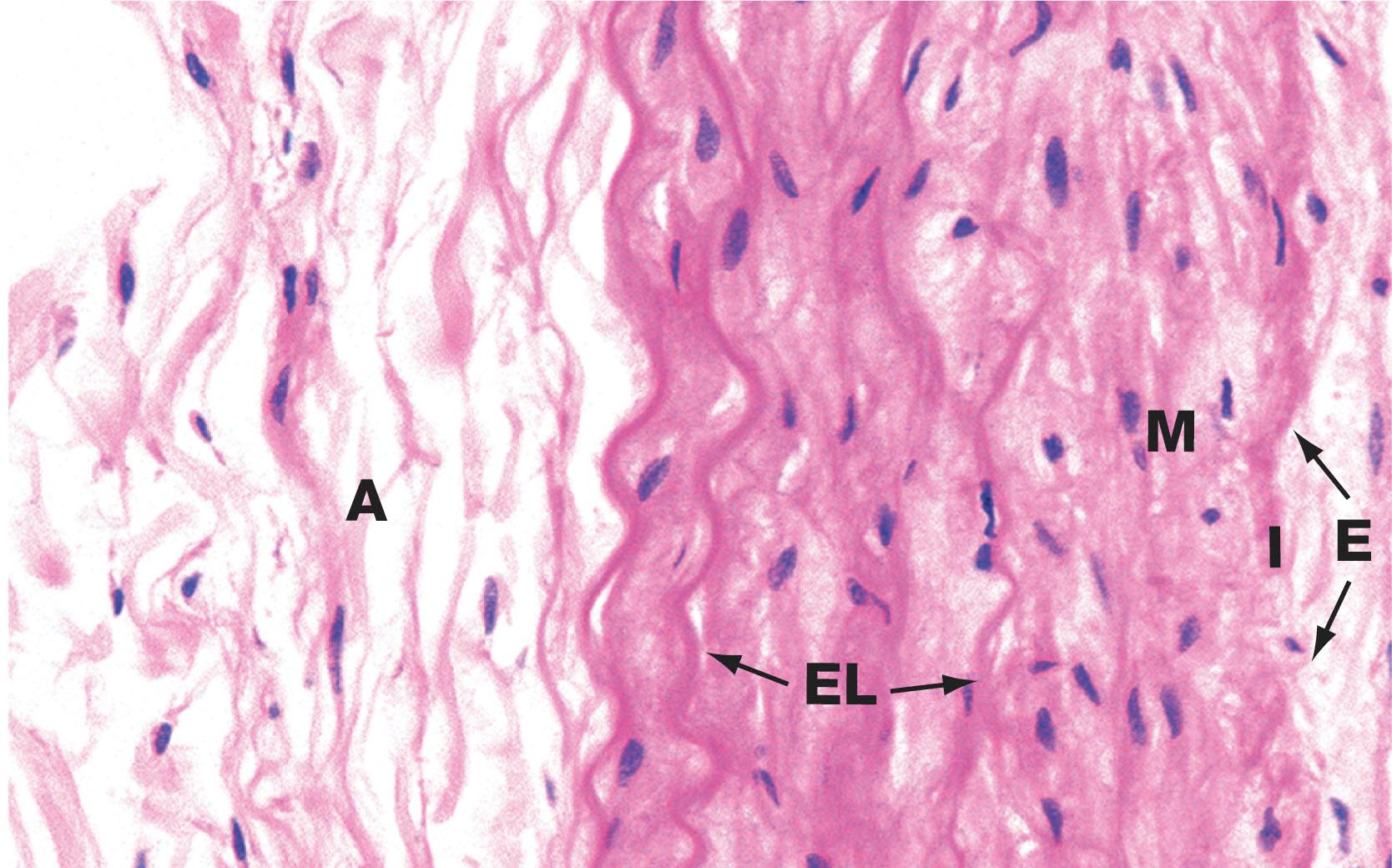
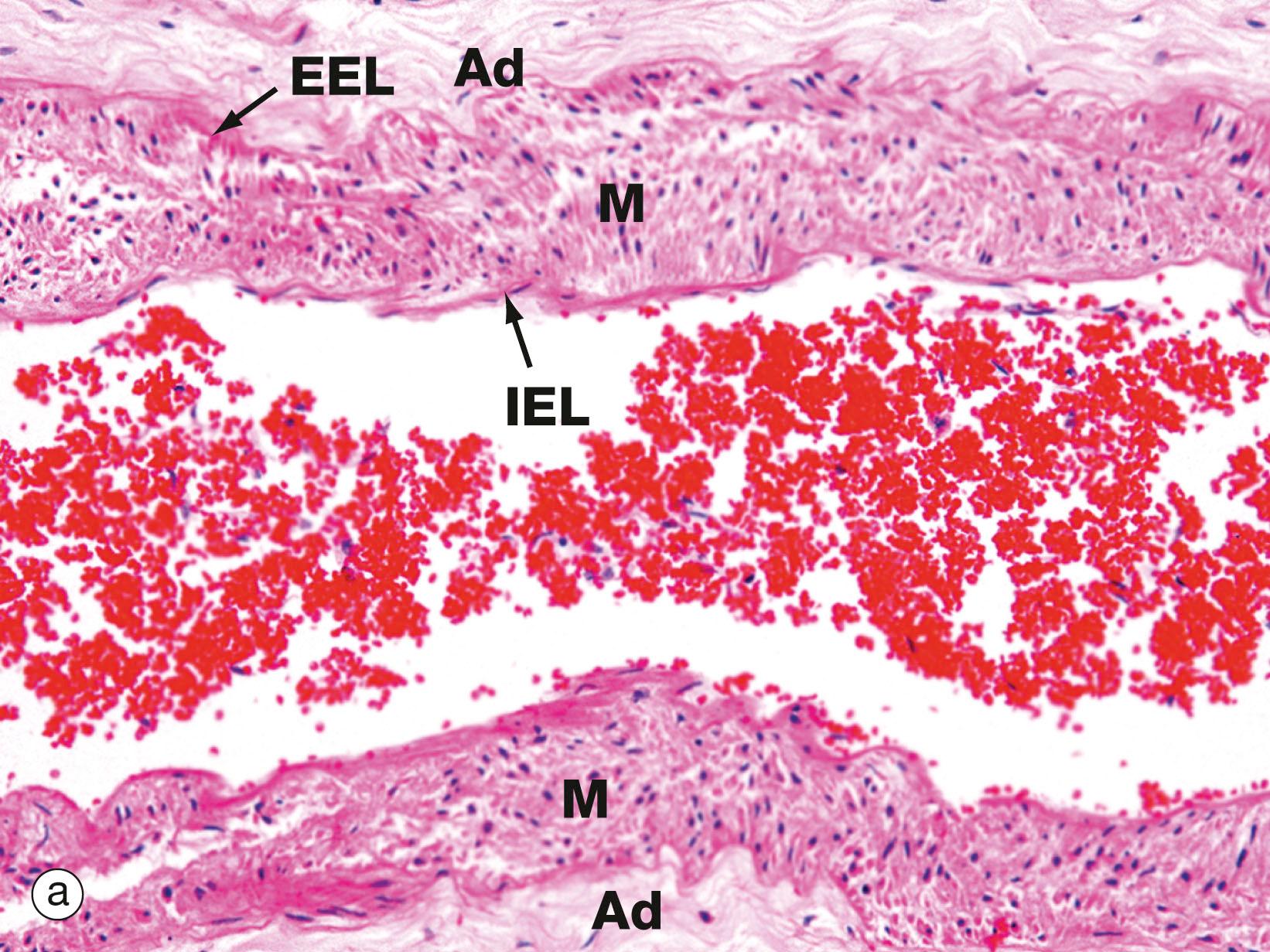
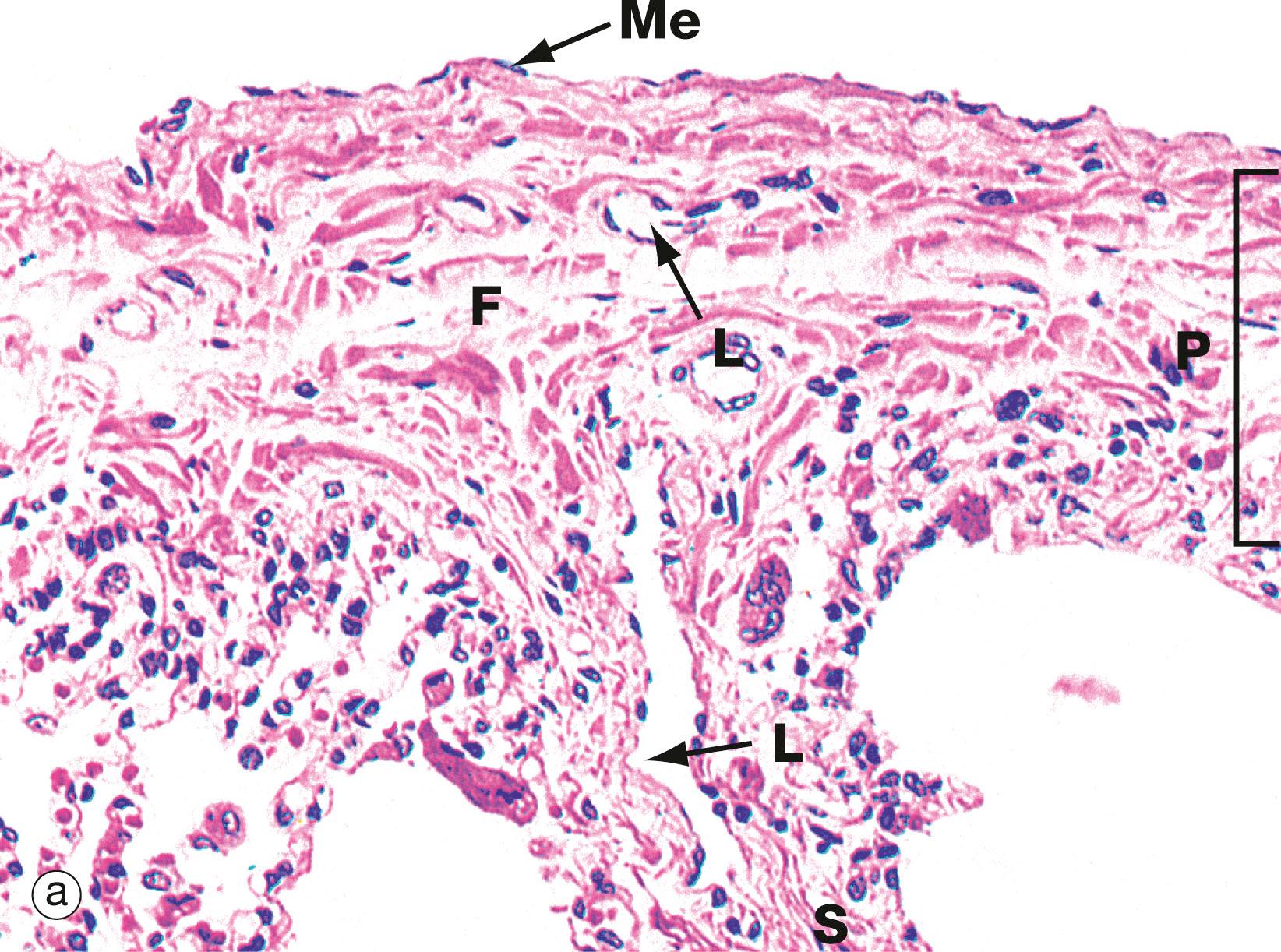
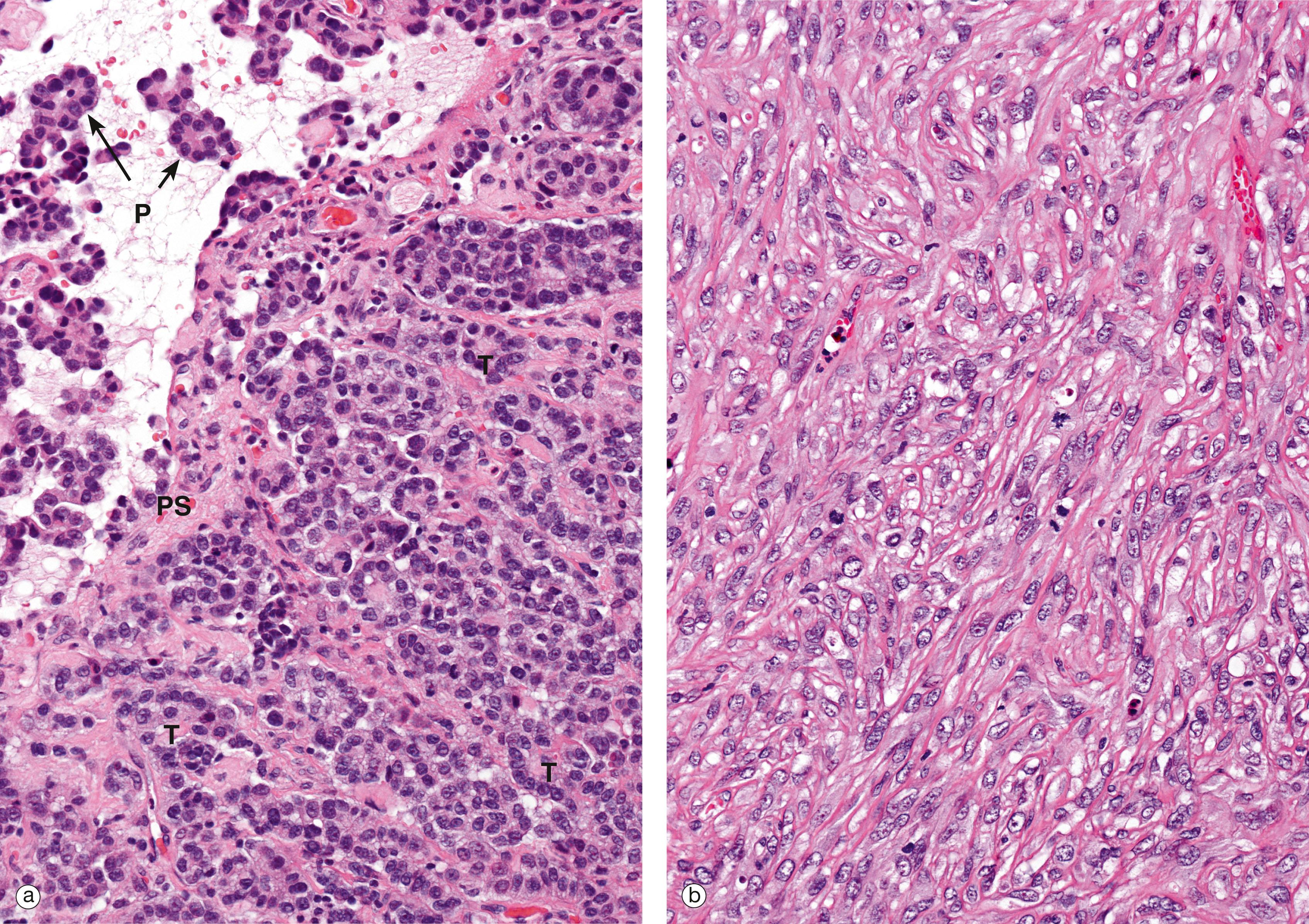
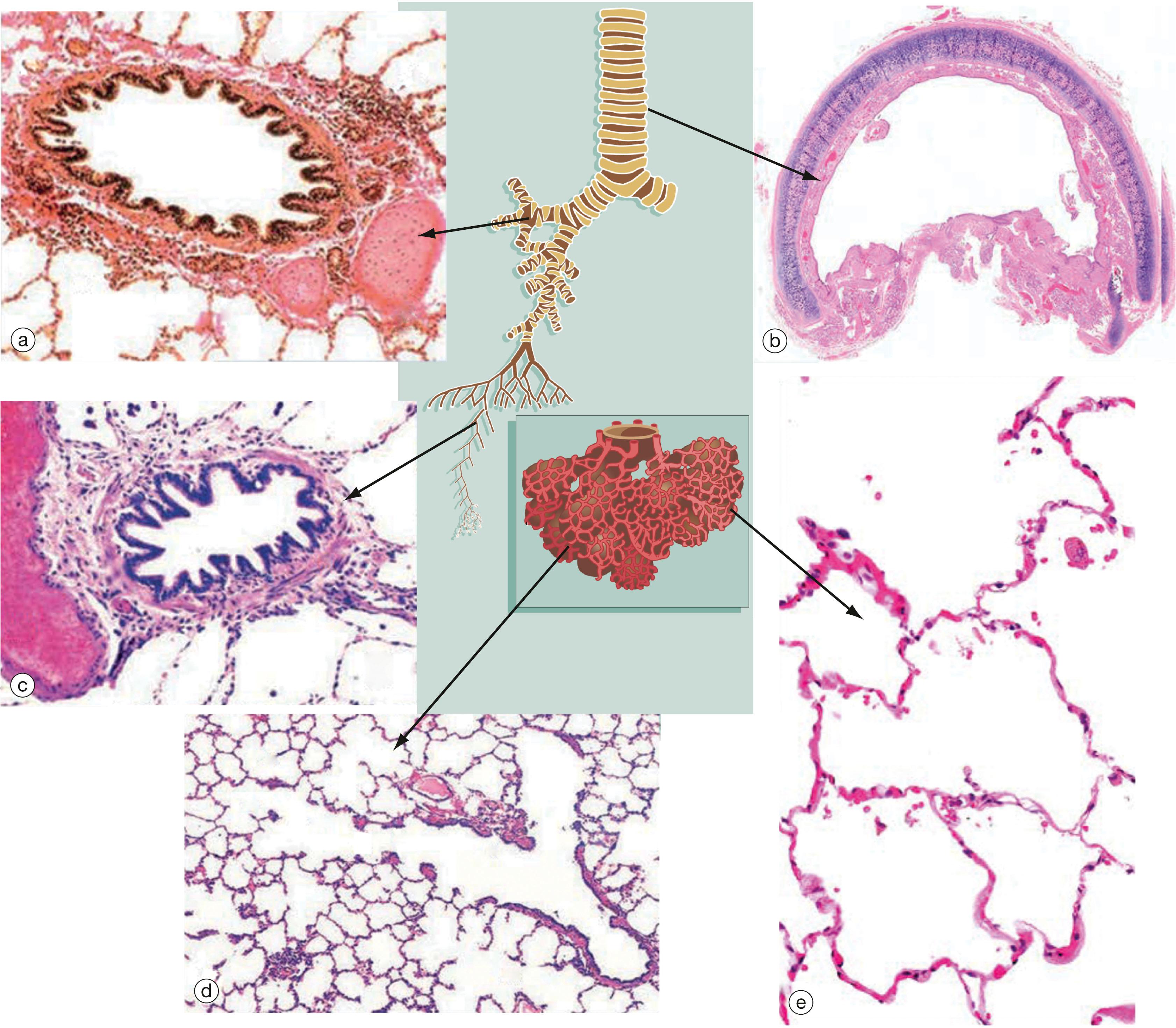
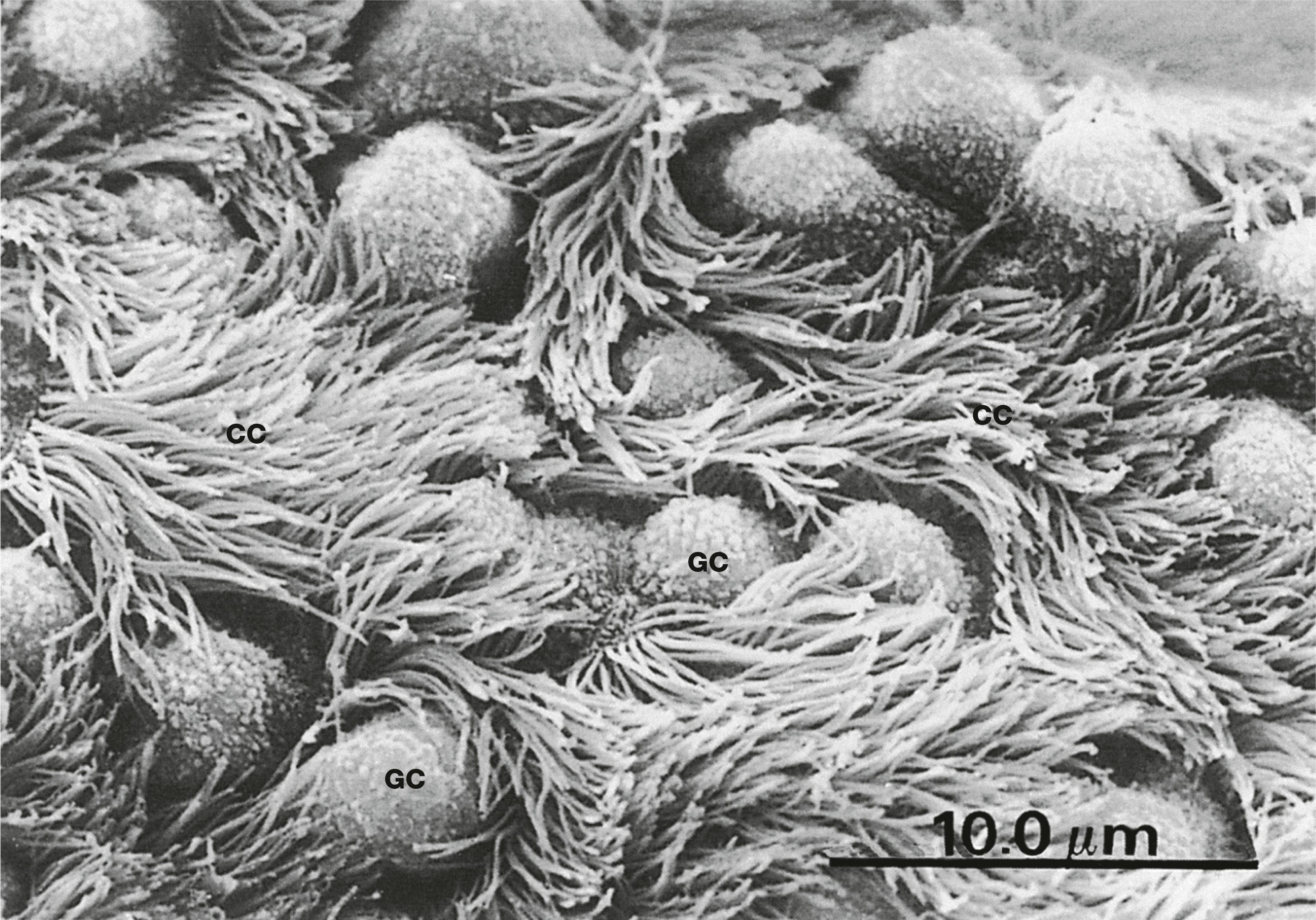
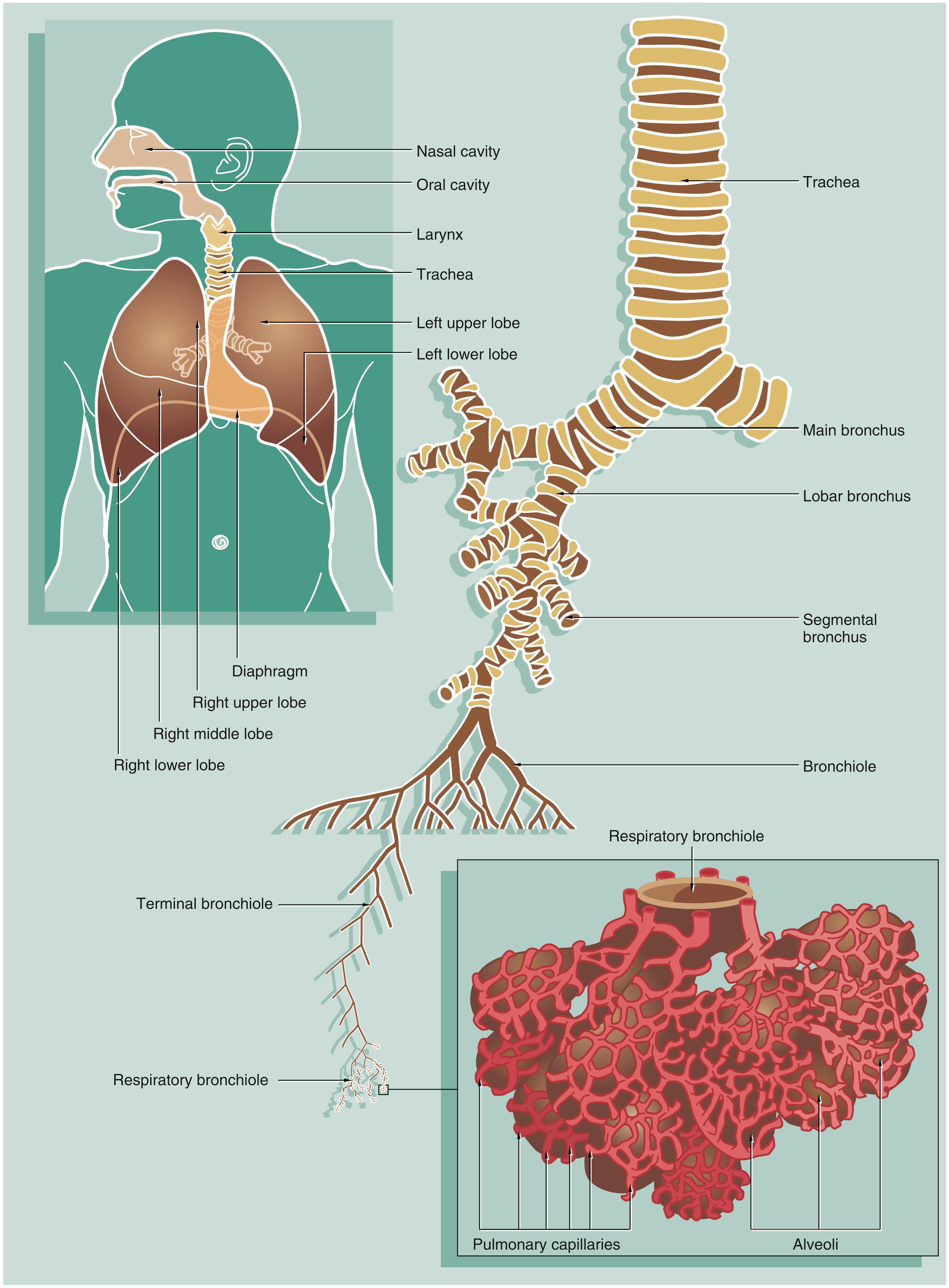
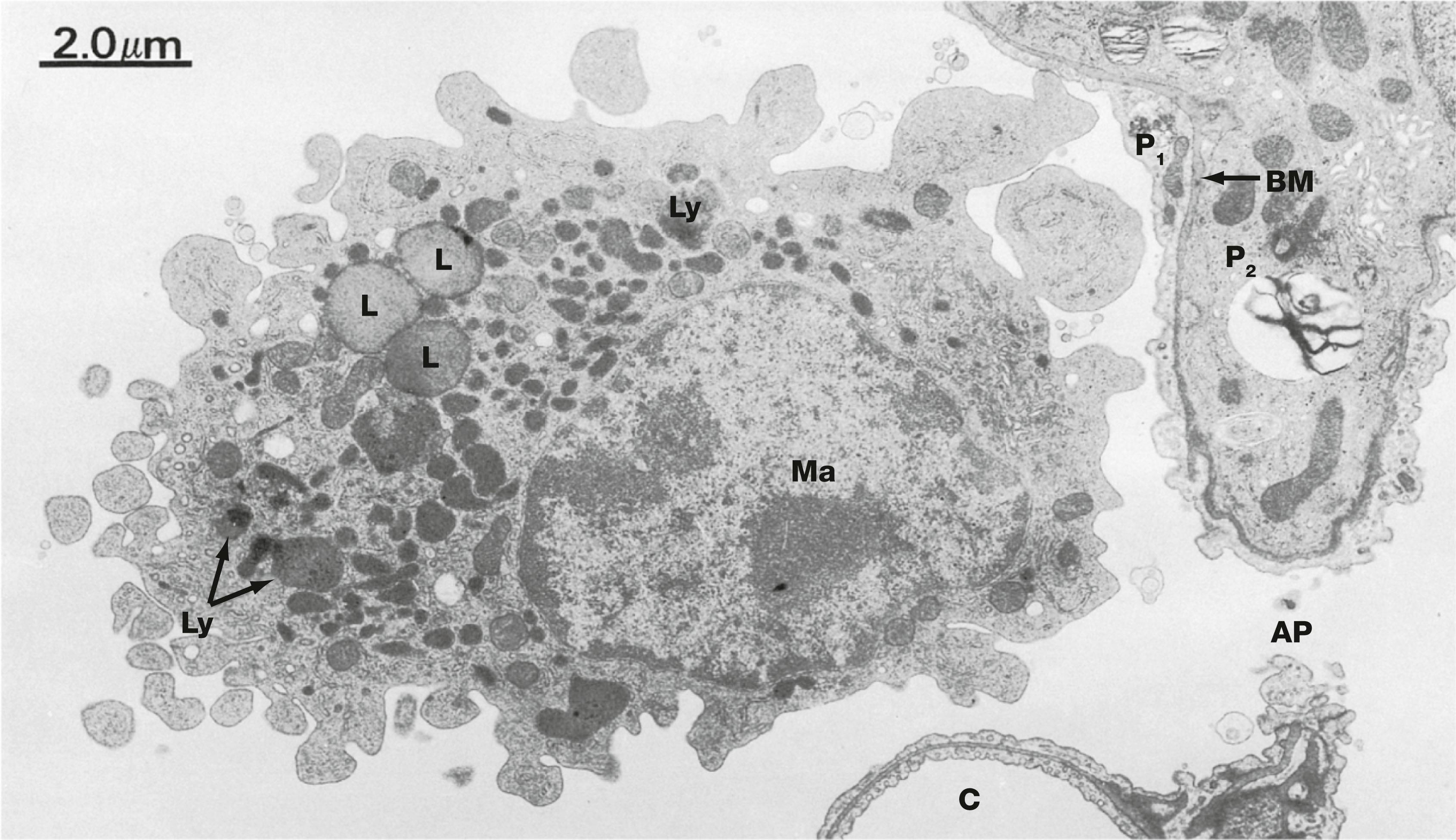
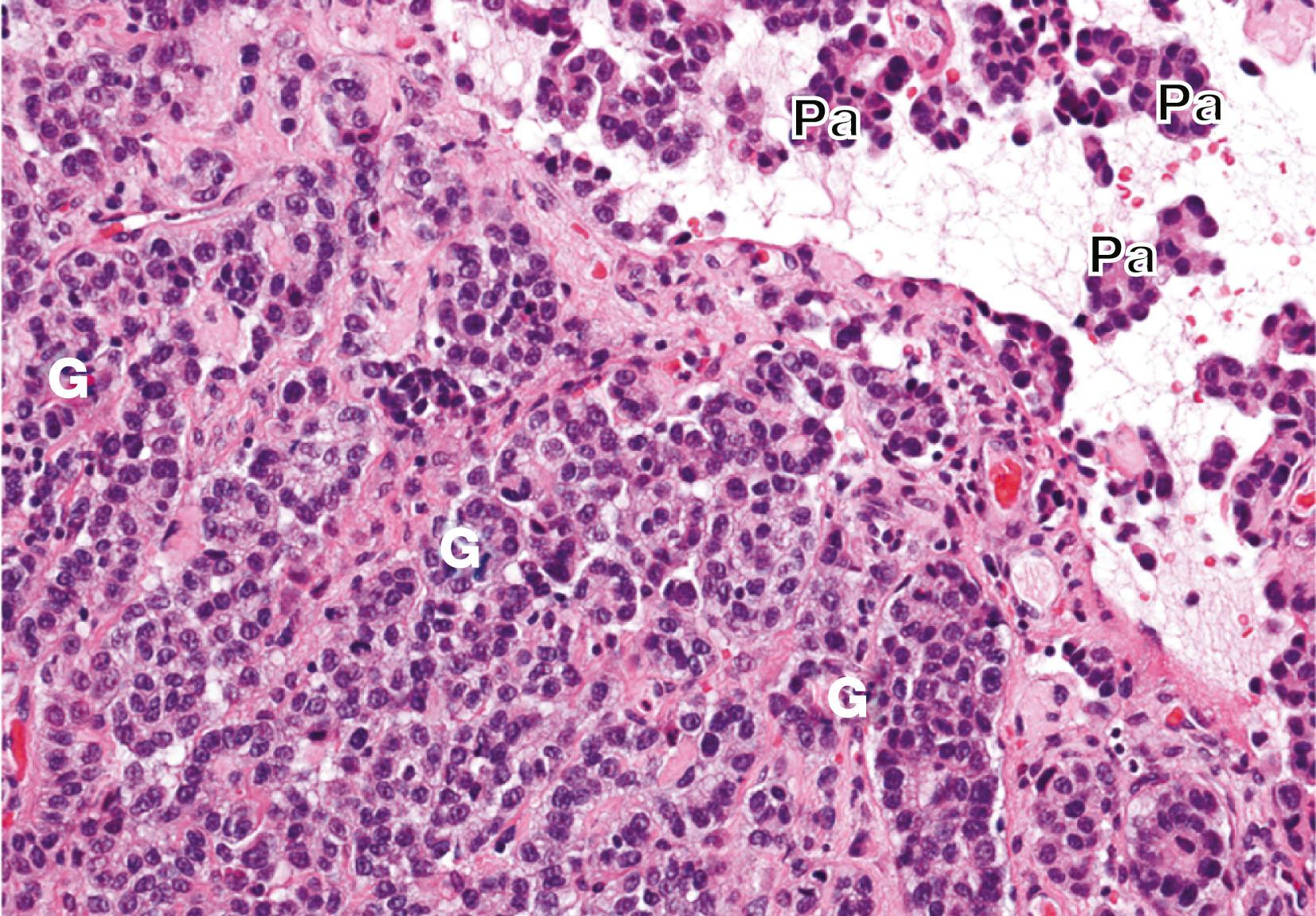
| Structure | Key components and features | Figures |
|---|---|---|
| Nasal cavity and sinuses | Adjust temperature and humidity of inspired air, role in trapping inspired particulate debris | 12.2 |
| Lined by respiratory-type mucosa (pseudostratified ciliated columnar epithelium with goblet cells) | 12.3 | |
| Lamina propria includes seromucinous glands and many blood vessels, important in humidifying and warming air | 12.3 | |
| Specialised area of olfactory mucosa in roof of nasal cavity | 21.2 | |
| Nasopharyngeal mucosa includes prominent lymphoid tissue, the adenoid or nasopharyngeal tonsil forming part of Waldeyer ring | 12.4 | |
| Larynx | Part of upper airway; includes vocal cords, which are mucosal folds protruding into lumen of airway | |
| Mostly respiratory-type mucosa, but vocal cords are lined by squamous mucosa, better suited to effects of chronic friction from contact between cords on vocalisation | 12.5 | |
| Seromucinous glands in submucosa | 12.5 | |
| Muscles involved in vocalisation lie within wall of larynx | 12.5 | |
| General structure of larynx is formed from cartilage, stiff but flexible and well suited to keeping airway open and protected | ||
| Tracheobronchial tree (conducting airways) | Trachea and major bronchi are tubular structures with rings or plates of cartilage to prevent collapse during inspiration | 12.6 , 12.26 |
| Lining of respiratory type mucosa with underlying seromucinous glands in submucosa in larger airways | 12.7 | |
| Band of smooth muscle between mucosa and submucosa, more prominent in smaller airways | 12.8 | |
| Segmental bronchi lack submucosal glands and have only occasional plates of supporting cartilage | 12.10 , 12.26 | |
| Bronchioles are less than 1mm in diameter and lack cartilage and submucosal glands | 12.11 | |
| Distal airways have fewer goblet cells but do have Clara cells (produce surfactant components, act as stem cells and have role in detoxifying noxious agents) | 12.11 , 12.12 , 12.26 | |
| Lung parenchyma | Respiratory bronchioles have alveoli in their walls and branch to form alveolar ducts and terminate in alveolar sacs | 12.12 , 12.26 |
| Alveoli are small air-filled pouches with flattened pneumocytes and rich capillary network—site of gas exchange (thin blood–air barrier) | 12.12–12.16 | |
| Type I pneumocytes are very flat and attenuated, whilst type II pneumocytes are rounded cells which produce surfactant | 12.15–12.16 | |
| Lung vasculature | Dual circulation:
|
12.22 , 12.23 |
| Pleura | Pleural cavities are lined by mesothelium and contain a small volume of serous fluid for lubrication during the movements of respiration | 12.24 |
| Visceral and parietal layers are separated by a potential space |
Become a Clinical Tree membership for Full access and enjoy Unlimited articles
If you are a member. Log in here